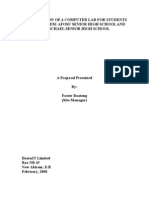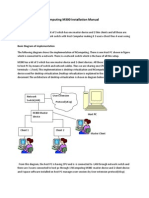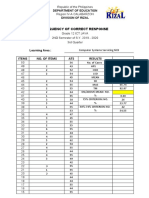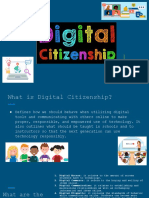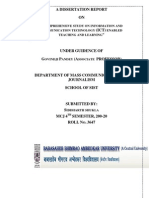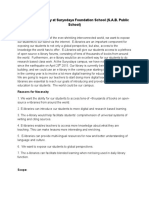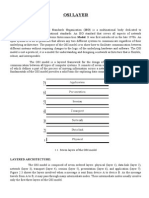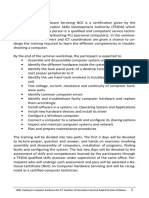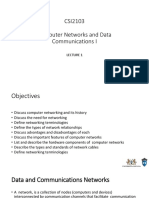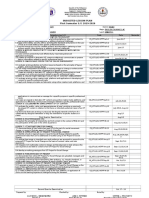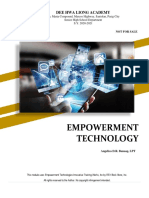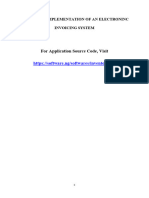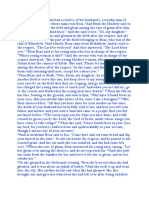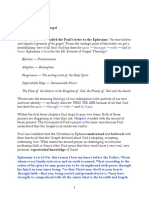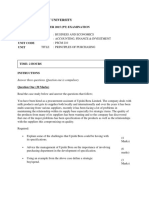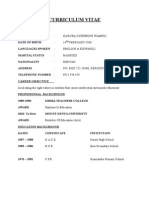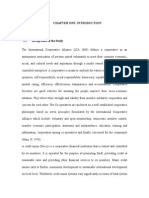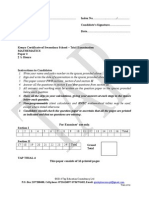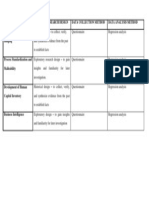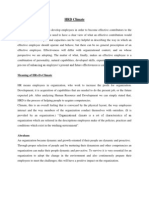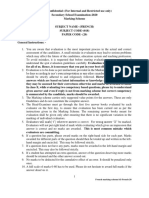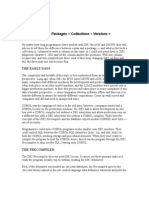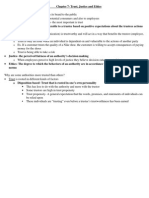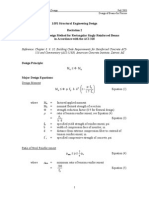Ict Proposal
Uploaded by
James GikingoIct Proposal
Uploaded by
James GikingoAN ANALYSIS OF FACTORS INFLUENCING THE PEDAGOGICAL INTEGRATION OF ICT IN PUBLIC SECONDARY SCHOOLS IN NAIROBI COUNTY, KENYA.
BY KIRUI NICHOLAS KIPKOECH
RESEARCH
PROJECT
REPORT
SUBMITTED
IN
PARTIAL
FULFILLMENT OF THE REQUIREMENTS FOR THE AWARD OF THE DEGREE OF MASTER OF ARTS IN PROJECT PLANNING AND MANAGEMENT OF THE UNIVERSITY OF NAIROBI.
2011. DECLARATION This research project report is my original work and has not been presented for academic purposes in the University of Nairobi or any other University. Sign.Date irui Nicholas ipkoech !"#$%#&'#$(##%
This project report has been submitted with our approval as university supervisors
Signed..Date Dr. )hristopher *akuu Senior !ecturer+ Department of ,-tra .ural Studies+ University of Nairobi.
Signed..Date................... Dr. /arriet idombo Senior !ecturer+ Department of ,ducational Studies+ University of Nairobi.
ii
DEDICATION This research project is dedicated to my parents ipkirui 0rap )hepkwony and
Tapsabei )hepkwony for their prayers and support+ my brothers 0le-ander+ 1oseph+ 2hilip+ 0lfred+ )harles+ David+ 1ulius+ ,dwin+ 3ernard and all my siblings for giving me a chance to be a role model and for inspiring me towards further studies.
iii
ACKNOWLEDGEMENTS 4 thank my supervisors Dr. /arriet idombo and Dr. )hristopher *akuu for being
there for me whenever 4 re5uested for clarifications and for their wise counsel. 4 am also indebted to 2rof. .aitho+ 2rof. 2rokariyal+ 2rof. .acharia and .s 2atricia .uchiri for guiding me in correcting my proposal and towards completing my research project. 4 cannot forget to thank my colleagues ,ddah 3iegon and 6alter oech for enabling
me to access research materials. 4 am also grateful to my wife Nelly )heptoo+ )lement !elei+ 1ustus Sang+ Simon 7uko+ 1anet .utai and en .utai for their crucial support towards completing my research. Special thanks to all the staff of ,-tra .ural department and School of )ontinuing and Distance ,ducation for giving me the opportunity to pursue the .asters program. !ast but not least+ 4 deeply appreciate my colleagues and group members at the university8 9ebecca 6ainaina and Sheila throughout the course. ituyi for their support and cooperation
iv
TABLE OF CONTENTS Pa ! 2.2 G"#$a" ICT %&'! (a'%#&........................................................................................12 2.) E**!+' #* *a+! $##, #& a+a-!.%+ /!(*#(.a&+!. ...............................................10 9esearch has found the website as damaging students: academic performance. ;ace book users may feel socially successful in cyberspace but they are more likely to perform poorly in e-ams+ according to new research into the academic impact of the social networking website <3rown+ (##=>. .......................................................&= .............................................................................................................................%=
LIST OF TABLES Pa ! Table (.& ? 2ositive and negative factors influencing perceived ease of use ...(@ Table (.( ? 2ositive and negative factors influencing perceived usefulness.....(' Table @.& respondents and 5uestionnaires issued.@# Table @.(A .easurement of variables........@' Table '.& Survey 9eturn 9ate.......@% Table '.(A )haracteristics of the respondents.......@B Table '.@A 4)T infrastructure in schools....@= Table '.'A ;re5uency of use of 4)T in performing various activities.......'# Table '."A Training and use of computers among teachers.......'& Table '.CA UtiliDation of 4)T among teachers...'( Table '.%A UtiliDation of 4)T among students..........'@ Table '.BA )omparison of 4)T infrastructure among the B schools..'' Table '.=A Use of internet and 4)T usage for administrative purposes.....'" Table ".&A Summary of research findings....."#
vi
LIST OF FIGURES Pa ! ;igure (.& ? Technology acceptance model.(( ;igure(.(A conception framework....(C
vii
ABBREVIATIONS AND ACRONYMS ICT1 GDLN W#(LD AERA NGO1 NIS TTC INSET NEPAD PRESET TESSA TTISSA AVU TSC INTEL NETTEL UNESCO MDG1 BPO NIE R2D OECD LCD VSAT LAN 4nformation and communication technologies *lobal Distance !earning Network 6orld !inks for Development 0merican ,ducational 9esearch 0ssociation. Non?governmental organiDations Nairobi 4nternational School Teachers Training )olleges 4n?service Training New 2artnership for 0frica Development 2re?service Teacher Training Teacher ,ducation in Sub?Saharan 0frica Teacher Training in sub?Saharan 0frica 0frica Eirtual University Teachers Service )ommission 4ntegrated electronics Network Telecommunications United Nations ,ducational+ Scientific and )ultural 7rganiDation .illennium Development *oals 3usiness 2rocess 7utsourcing National 4nstitute of ,ducation 9esearch and Development 7rganiDation for ,conomic )o?operation and Development !i5uid )rystal Display Eery Small 0perture Terminal !ocal 0rea Network
viii
ABSTRACT This research was undertaken to investigate and analyDe factors influencing the pedagogical integration of 4nformation )ommunications Technology <4)T> in public secondary schools in Nairobi )ounty+ enya. The data was collected by means of 5uestionnaires administered to ('# students+ (' teachers and B principals. 4nterviews and observations were also done in the eight schools. The objectives of the study were8 to compare the e-tent of 4)T integration for pedagogy in the selected secondary schools in Nairobi+ to assess the attitudes students and teachers towards the use of 4)T e5uipments for teaching learning purposes+ to analyDe the availability of 4)T facilities for use in teaching$learning and administration and to assess the internet connectivity for pedagogical use in the selected schools. The findings indicated that there is lack of sufficient 4)T e5uipment$facilities hence cannot match the high number of students in the schools. This was contributed by lack of enough funds to buy updated software:s and digital teaching materials. Seven out of eight schools surveyed lack internet connectivity+ which they attribute to the high cost associated with internet connection. .ost of the teachers have a positive attitude towards 4)T use. They are involved in professional development activities including after school computer classes$sessions+ in?service training courses and online training courses. /owever+ majority of the teachers <CC.%F> do not use computers for teaching due to too much lessons per week and restrictions by the administration on the use of computers. .ost of the students also prefer using 4)T for learning purposes. .ajority of the students mentioned that they lack teachers trained in 4)T+ have few 4)T lessons given in the schools and that the computer studies is less compulsory hence making the less interested students to avoid the lessons. ;rom the study+ most students and teachers rarely use internet to obtain learning resources due to lack of internet connection in the schools. 7nly in ( schools+ C&?B#F of students use internet and only in one school+ more than C#F of the teachers was reported to be using internet. .ost students spend a lot of time to network with friends in the face book website. .ost of the staff members lack computer skills. Teachers lamented on limited access to the available computers and restricted internet usage. 4n addition+ use of 4)T demanded a lot of time+ for instance making slides for teaching+ which they e-plained could slow down syllabus coverage. Some teachers however were not well versed with computer usage for teaching purposes+ for instance preparing power point slides. )omputers are being utiliDed for planning+ preparation and administration. 0ccording to the administrators+ each of the schools had computers and at least one computer was available for use. The study recommends revision of rigid school 4)T policies that restrict teachers and students from ma-imiDing the use of 4)T in pedagogy8 providing in?service training to all teachers on 4)T skills+ employment of more computer teachers and 4)T technicians+ government to increase funding to Gcomputer for schools programs: and that policy makers should incorporate and propagate 4)T use in the curriculum and to emphasiDe the importance of 4)T in schools.
&
CHAPTER ONE INTRODUCTION 1.1 Ba+, (#3&- '# '4! 1'3-5 4nformation )ommunication and Technologies <4)Ts> provide a window of opportunity for educational institutions and other organiDations to harness and use technology to complement and support the teaching and learning process. ,?learning is an e-ample of the use of these 4)T?supported teaching and learning methods whose use in educational institutions is gaining momentum with the passage of time <7mwenga+ (##'>. ,ducational systems around the world are under increasing pressure to use the new information and communication technologies <4)T> to teach students the knowledge and skills they need in the (&st century <6an+ (#&&>. 6ithin the past decade+ the new 4)T tools have fundamentally changed the way people communicate and do business. They also have the potential to transform the nature of educationA where and how learning takes place and the roles of students and teachers in the learning process. The challenge confronting our educational systems is how to transform the curriculum and teaching?learning process to provide students with the skills to function effectively in this dynamic+ information?rich+ and continuously changing environment. 4)Ts provide an array of powerful tools that may help in transforming the present isolated+ teacher? +!&'!(!- a&- '!6'7$#3&- +"a11(##.1 %&'# (%+4, 1'3-!&'7*#+31!-, %&'!(a+'%8! ,	"!- ! !&8%(#&.!&'1. T# .!!' '4!1! +4a""!& !1, "!a(&%& %&1'%'3'%#&1 .31' !.$(a+! '4! &!9 '!+4&#"# %!1 a&- a//(#/(%a'! ICT '##"1 *#( "!a(&%& . T4!5 .31' a"1# .#8! '#9a(-1 '4! #a" #* '(a&1*#(.%& '4! '(a-%'%#&a" /a(a-% . #* '!a+4%& :.arshall+ inuthia H Taylor+ (##=>.
enya has made remarkable progress putting in place an 4)T policy framework and implementation strategy complete with measurable outcomes and time frames. 4n (##C National 4)T policy was launched with the main objective of making enya an 4)T hub and a premier location for 3usiness 2rocess 7utsourcing <327> in 0frica <.illennium Development *oals status report for enya+ (##%>.This is a key step towards vision (#@# and attaining of .illennium Development *oals <.D*s>. The process has had the benefit of sound advice from officials and stakeholders and+ perhaps more importantly+ strong leadership from the office of the 2ermanent Secretary of the .inistry of ,ducation. /owever+ universal implementation is challenging given the lack of resources+ national 4)T infrastructure+ and even electrical supply I particularly in the rural areas. T4! #8!(&.!&' #* K!&5a '4(#3 4 '4! M%&%1'(5 #* E-3+a'%#& 4a1 "a3&+4!- a .3"'%7 .%""%#& I&*#(.a'%#& a&- C#..3&%+a'%#& '!+4&#"# 5 T(31' F3&-. I& 4%1 1/!!+4, a' a (a-3a'%#& +!(!.#&5 *#( ICT (a-3a&'1 a' '4! K!&5a I&1'%'3'! #* E-3+a'%#& #& N#8!.$!( 2;, 200<, '4! .%&%1'!( *#( !-3+a'%#& 1a%- '4a' '4! #8!(&.!&' 9a1 +#..%''!- '# /(#8%-%& 2)00 #* '4! =)00 /3$"%+ 1!+#&-a(5 1+4##"1 %& K!&5a 9%'4 +#./3'!(1 $5 '4! 5!a( 200;. T4! .%&%1'(5 !.$a(,!- #& '4%1 a.$%'%#31 /(# (a. '# +#&&!+' a"" /(%.a(5 a&- 1!+#&-a(5 1+4##"1 '# '4! I&'!(&!' %& 10 5!a(1. I& '4! *%&a&+%a" 5!a( 2000)>200? a&- 200?>200@, '4! #8!(&.!&' 1!&' 1.) .%""%#& 14%""%& 1 '# !a+4 #* '4! 210 1!+#&-a(5 1+4##"1 a1 14#9& %& a//!&-%6 A. T4! .#&!5 9a1 .!a&' '# !B3%/ '4! 1!"!+'!- 1+4##"1 9%'4 +#./3'!(1 :M3(%%'4% 200)C. The ,ducation permanent secretary announced that si- schools woul- $!&!*%' *(#. a /%"#' /(# (a. 94%+4 9a1 #**%+%a""5 "a3&+4!- #& S!/'!.$!( 20 200) DW! &#'! '4a' K!&5a %1 a.#& 1? +#3&'(%!1 1!"!+'!- '# $!&!*%' *(#. '4! *%(1' /4a1! #* '4! !7 %&%'%a'%8! $5 '4! N!9 Pa('&!(14%/ *#( A*(%+aE1 D!8!"#/.!&' :N!/a-C. T4! /(# (a. %1 '# /(#8%-! ,	"!- ! a&- (!a"7"%*! !6/!(%!&+! $5 %./"!.!&'%& %&*#(.a'%#& +#..3&%+a'%#& '!+4&#"# %!1 :ICTC %& 1+4##"1 a+(#11 A*(%+a '4a' 9%"" %&*#(. '4! .#-!" *#( a "a( !71+a"! (#""#3'F. T4! P!(.a&!&' S!+(!'a(5 :PSC 1a%- '4a' '4!
G#8!(&.!&' 4a- !&'!(!- %&'# a& a (!!.!&' 9%'4 M%+(#1#*' '# 13//"5 +#./3'!(1 '# 1+4##"1 a&- '4a' S41.) .%""%#& 4a- $!!& (!"!a1!- '# $35 '4! .a+4%&!1. GW! a(! +#..%''!- '# %&'! (a'%& ICT %&'# #3( !-3+a'%#& 151'!. a&- a(! %&8!1'%& %& a++!11, !B3%/.!&' a&- 1,%""1,G '4! PS 1a%- <)ommonwealth Secretariat+ (##C>. The private sector is doing a commendable job in introducing 4)T to schools. 7ne such non?governmental organiDation is )omputer for Schools ? to enya whose mission is to provide enyaJs youth with access to modern Technology through donation of computers enyan 2ublic secondary Schools <9eddick+ (#&#>. 0s at now+ @## secondary schools enya School 7&!' %1 a"1# a&#'4!( /(%8a'! have so far been supplied with computers.
#( a&%Ha'%#& '4a' 4a1 'a,!& '4! %&%'%a'%8! '# 1'a(' a T(a%&!( #* T(a%&!( '(a%&%& /(# (a.. Ba(+"a51 $a&, #* K!&5a %1 a"1# #&! 13+4 /(%8a'! +#./a&5 '4a' 4a1 a"1# -#&a'!- +#./3'!(1 '# 1+4##"1. I& 200< %' -#&a'!- 20 +#./3'!(1 '# a /3$"%+ 1!+#&-a(5 1+4##" %& Na%(#$%. Despite all these efforts+ '4! B3!1'%#& %1, a(! '4!1! +#./3'!(1 $!%& 31!- '# !&4a&+! '!a+4%& a&- "!a(&%& %& #3( 1!+#&-a(5 1+4##"1I I& '4! +3((!&' +3((%+3"3., a +#./3'!( 1'3-5 %1 a 1!/a(a'! "!a(&%& a+'%8%'5>13$J!+'. Na'%#&a""5, '4!(! a(! 110 +#./3'!( '!a+4!(1, 9%'4 #&"5 ) %& Na%(#$% /(#8%&+! :a//!&-%6 AIIC. L!a(&!(1 a(! $!%& 'a3 4' 4#9 '# $! +#./3'!( "%'!(a'!, a&- &#' 4#9 '# 31! +#./3'!(1 '# !&4a&+! "!a(&%& . W! &!!- .#-!"1 '# 1!(8! a1 !6a./"!1 #* 4#9 +#./3'!(1 +a& $! 31!- '# /(#.#'! "!a(&!(7+!&'!(!- !-3+a'%#& a&- '4! a//(#a+4 31!- (!*"!+'1 a %&'! (a'%#& #* ICT1 %& '4! '!a+4%& a&- "!a(&%& /(#+!11 :M3(%%'4%, 200)C. This study investigated the factors affecting the integration of 4)T in public secondary schools within Nairobi )ounty. There are C= public secondary schools in Nairobi )ounty. Nairobi is the capital of enya and its geographic coordinates are &K&CJS latitude and @CK'BJ, longitude <)lose H 0skew+ (##'>. Nairobi is the most populous city in ,ast !&!(a" .#8!.!&' a9a5 *(#. D'!a+4%& +#./3'!(1F '#9a(- 31%& ICT a1 !-3+a'%#&a" '##"1K
'
0frica+ with a current estimated population of about @.& million. The )ity of Nairobi enjoys the status of a full administrative county. 4t is now under the ministry of Nairobi .etropolitan <appendi- 4L>. 1.2 S'a'!.!&' #* '4! /(#$"!.. Despite the importance of 4)T <4nformation and )ommunication Technology> as a school subject in secondary education+ there is a lack of an integrated 4)T pedagogy that is elucidated within a broad framework of educational practice. 4)T use has been relegated to the periphery with teachers sticking to the traditional chalk and talk approach to teaching and learning. The focus is still on technicalities and reproduction of knowledge rather than conceptual understanding of 4)T. To realiDe the potential inherent in 4)T+ there is a need for innovative 4)T pedagogies in secondary education < rumsvik+ 9. (##C>. 0lthough there is some emphasis on 4)T in secondary schools+ 4)T pedagogy is still in its infancy and there is a lack of essential computer skills among teachers+ partly because+ in contrast to mathematics+ 4)T as a school subject is a young discipline <6oollard+ (##">.6hile there is a huge literature on the use of 4)T as a tool in teaching and learning+ there is much less published research work on the teaching of 4)T as a school subject. 0s a result+ there have been in the past and there persist even now strong disagreements about the nature of 4)T or similar designations+ such as informatics or computer science+ its aims+ content+ teaching and learning methods+ and assessment approaches </ammond+ (##'>. The study therefore sought to investigate and analyDe how the selected factors influence the use of 4)T in the selected public secondary schools in Nairobi )ounty.
"
1.= P3(/#1! #* '4! 1'3-5 The purpose of this study was to analyDe factors influencing the pedagogical integration of 4)T in the selected public secondary schools in Nairobi )ounty. 1.< R!1!a(+4 #$J!+'%8!1 The study aims at achieving the following objectivesA? &. To compare the e-tent of 4)T integration for teaching and learning in the selected secondary schools in Nairobi. (. To assess the attitudes of students and teachers towards the use of 4)T e5uipments for teaching and learning purposes in the selected schools. @. To analyDe the availability of 4)T facilities for teaching+ learning and administration in the selected schools. '. To assess the internet connectivity for pedagogical use in the selected schools. 1.) R!1!a(+4 Q3!1'%#&1 The study is based on the following research 5uestionsA? &. 6hat is the e-tent of 4)T integration for teaching and learning in the selected secondary schools in NairobiM (. 6hat are the attitudes of the students and teachers towards the use of 4)T e5uipments for teaching and learning purposesM @. /ow are the 4)T facilities available for teaching+ learning and administration in the selected schoolsM '. /ow is the internet connectivity for pedagogical use in the selected schoolsM 1.? S% &%*%+a&+! #* '4! 1'3-5 4t is of paramount importance that schools should embrace 4)T use by both teachers and students in order to improve the 5uality of teaching and learning. 4t also helps to cope with the worldwide use of 4)T to address increasing human needs <9ehmeyer+ (##%>.
The study considered teachers+ students and administrators as the key players towards pedagogical integration of 4)T in secondary schools. 4ncreased use of 4)T by secondary students provides them with a sound technological base for integration of 4)T in the higher echelons of learning and other spheres of life. 1.@ D!"%.%'a'%#& #* '4! 1'3-5 The study was carried out in Nairobi )ounty where most of the schools have access to 4)T infrastructure. The schools also are more accessible electricity compared to schools in rural areas where the power supply is not ade5uate. 1.; L%.%'a'%#&1 #* '4! 1'3-5 The research instrument gave varying data depending on the individuals or schools where it is used. The shortcoming was addressed by applying both 5uantitative to 5ualitative approaches to research. Due to technological dynamism+ approaches to 4)T use can change within a short time+ rendering the research findings obsolete. 0lso+ the study of Nairobi schools where electricity and 4)T accessibility is high means that the results may not be generaliDed to rural areas where 4)T infrastructure is inade5uate. 1.0 A113./'%#&1 #* '4! 1'3-5 The study assumed that the selected sample was a good representative of all the secondary schools in Nairobi )ounty. 0ll the selected public secondary schools were treated to have embraced the 4)T in their teaching and learning. The 5uestionnaires used gave precise data and that the element of biasness never set in during the data collection and analysis. The respondents+ in this case students+ teachers and administrators were also e-pected to cooperate with the researchers in order to make the study both valid and reliable.
&.&#
T4! 1+#/! #* '4! 1'3-5
The study was carried out in Nairobi province+ enya. 4t involved eight schools out of the current seventy. The study sought information from students+ teachers and administrators. 1.11 D!*%&%'%#&1 #* 1% &%*%+a&' '!(.1
ICT <I&*#(.a'%#& C#..3&%+a'%#&1 T!+4&#"# 5C %&'! (a'%#& for the purpose of this study is taken to mean the overall use of computers and computer?related technologies for teaching and learning. P!-a # %+a" %&'! (a'%#& #* ICT ;or the purposes of this study means the use of computers and computer?related technologies for teaching and learning among the young learners. D!/!&-!&' 8a(%a$"! 4n this study+ it is a group of factors which affect the pedagogical integration of 4)T. I&-!/!&-!&' 8a(%a$"! 4ndependent variable in the study is the integration of 4)T by both students and teachers in teaching and learning. I&'!(&!' +#&&!+'%8%'5 4t is the e-tent to which the components <nodes> of computers network are connected to one another and the ease <speed> with which they can Jconverse.J I&1'(3+'%#&a" /"a&17 4deas that specialiDed instructional supports need to be in place in order to best facilitate learning when students are first introduced to a new subject or concept.
ICT /#"%+%!17 described as principles or rules to guide decisions on computer usage and achieve rational outcome<s>. Sa./"!? 0 population is a group of individuals persons from which samples are taken for measurement for e-ample a population of teachers+ administrators and students. 1.12 S3..a(5
)hapter one of the study provides a solid background to the research. 4t also highlights the intention of the proposed research+ sheds light on the overall meaning of 4)T and what the researcher aimed at achieving by the end of the study and outlines some e-pected challenges and possible mitigation measures. The chapter ends by e-pressing optimism that the research could generate useful information for supporting 4)T integration as a pedagogical tool in public secondary schools.
CHAPTER TWO LITERATURE REVIEW 2.1 I&'(#-3+'%#& 4nformation )ommunications Technology <4)T> covers any product that will store+ retrieve+ manipulate+ transmit or receive information electronically in a digital form+ for e-ampleA personal computers+ digital television+ email and robots <Scholten+ Eelde H .anen+ (##=>. 4t is also concerned with the way these different uses can work with each other. 4nformation )ommunication and Technologies <4)Ts> provide a window of opportunity for educational institutions and other organiDations to harness and use technology to complement and support the teaching and learning process. ,?learning is an e-ample of the use of these 4)T?supported teaching and "!a(&%& J3&! 200<C. 4n the last two decades+ research studies of information and communication technologies <4)T> in education have shifted away from the analytic study of single learning and instructional variables towards the whole configuration of events+ activities+ contents+ and interpersonal processes taking place in the conte-t that 4)T is used <;ontana+ Dede+ 6hite+ H )ates+ &==@8 /errington H 7liver+ &==B8 1onassen+ 2eck+ H 6ilson+ &===8 Sarapuu H 0dojaan+ &===8 7liver H /annafin+ (###8 1onassen+ (###8 1onassen H )arr+ (###8 /ollingworth H .c!oughlin+ (##&8 earney H Treagust+ (##&8 Neo H Neo+ (##&>. These studies have shown that 4)T+ like any tools in the learning environment+ may be used well or poorly+ and care and e-perience are needed when using it. .!'4#-1 94#1! 31! %& !-3+a'%#&a" %&1'%'3'%#&1 %1 a%&%& .#.!&'3. 9%'4 '4! /a11a ! #* '%.! :O.9!& a,
&#
4)T tools can be classified into four categoriesA
informative tools+ situating tools+
constructive tools+ and communicative tools. 4nformative tools are applications that provide vast amounts of information in various formats such as te-t+ sound+ graphics+ or video. 4nformative tools do not really NdoN anything8 rather they are considered as huge+ passive+ repositories of information. Situating tools are systems that situate students in an environment where they may Ne-perienceN the conte-t and happenings. ,-amples of such systems include simulation+ games+ and virtual reality <)hen+ /su+ H /ung+ (###>. )onstructive tools are general?purpose tools that can be used for manipulating information+ constructing oneJs own knowledge or visualiDing oneJs understanding. The term NconstructiveN stems from the fact that these tools enable students to produce a certain tangible product for a given instructional purpose. ;or e-ample+ web authoring applications allow students to create their own web pages and communicate their ideas to the world. )ommunicative tools are systems that mediate communication between the teacher and students or among students beyond the physical barrier <either by space+ time+ or both> of the classroom. ,-amples of communicative tools include e?mail+ electronic bulletin boards+ chat+ teleconferencing+ and electronic whiteboards <2ing H Oong+ (##@>. 4nformation and communication technology <4)T> is not a panacea for all educational problems. /owever+ today:s technologies are essential tools for teaching and learning. To use these tools effectively and efficiently+ teachers need visions of the technologies: potential+ opportunities to apply them+ training and just?in?time support+ and time to e-periment. 7nly then can teachers be informed and confident in their use of new technologies < obayashi+ (##B>. Teaching is becoming one of the most challenging professions in our society where knowledge is e-panding rapidly and much of it is available to students as well as teachers
&&
at the same time .0s new concepts of learning have evolved+ teachers are e-pected to facilitate learning and make it meaningful to individual learners rather than just to provide knowledge and skills. .odern developments of innovative technologies have provided new possibilities to teaching professions+ but at the same time have placed more demands on teachers to learn how to use these new technologies in their teaching. These challenges ask teachers to continuously retrain themselves and ac5uire new knowledge and skills while maintaining their job <;ontaine+ ..+ (###>. Today+ a variety of 4)T can facilitate not only delivery of instruction+ but also learning process itself. .oreover+ 4)T can promote international collaboration and networking in education and professional development. ThereJs a range of 4)T options I from videoconferencing through multimedia delivery to web sites ? which can be used to meet the challenges teachers face today. 4n fact+ there has been increasing evidence that 4)T may be able to provide more fle-ible and effective ways for lifelong professional development for today:s teachers. 3ecause of rapid development in 4)T+ especially the 4nternet+ traditional initial teacher training as well as in?service continued training institutions worldwide are undergoing a rapid change in the structure and content of their training and delivery methods of their courses. /owever+ combining new technologies with effective pedagogy has become a daunting task for both initial teacher training and in?service training institutions <)ollis H 1ung+ (##@>.
2.2 G"#$a" ICT %&'! (a'%#&. There is no doubt that 4)Ts are seen as central to education in the (&st century. The Pueensland *overnment has made a huge commitment to promoting the use of new communication technologies through its 4)Ts for learning initiatives. These initiatives are part of the Pueensland *overnmentJs <(##(> policy+ ,ducation H Training 9eforms for the ;uture <3indloss+ (##(>.
&(
0 commitment to fund the area of 4)Ts with a large monetary support package indicates a commitment to delivering the education and hardware needed to service the needs of the information economy. This policy has practical effects+ reflected in the e-ample of the new Pueensland Technology Syllabus for Oears &?&#. This syllabus uses a learner? centered framework where Nthrough the e-periences and challenges of Jworking technologicallyJ+ students develop a range of associated knowledge+ practices and dispositionsN. Thus 4)Ts are seen in government policy to very much be just one of the tools for learning <2lotnick+ ,. (##'> 0ccording to previous studies in ;innish schools <!akkala+ !allimo H /akkarainen+ (##"8 !akkala+ 4lomQki H 2alonen+ (##%>+ the implementation of technology?supported collaborative in5uiry practices assumes teachers to design the educational setting as an integrated whole that provides students with relevant technological tools+ directs them to collaborate effectively+ and promotes epistemologically high?level and creative working with knowledge. 0s Singapore:s only pre?service teacher training institute+ the National 4nstitute of ,ducation <N4,> was entrusted with the responsibility for integrating 4)T into initial teacher training programs based on the nation:s .aster plan for 4T in ,ducation. 0ccordingly+ the N4, developed and began implementing a new 4)T plan in &==B+ which identified four main areas that needed changeA curriculum8 physical and technological infrastructure8 human resource infrastructure8 and 9 H D in the use of 4)T in education <1ung+ (##&>. 2.= ICT %& A*(%+aL1 E-3+a'%#& 0frica has witnessed the development of 4)Ts in various sectors over the last decade including education. The change from teacher?centred education system to learner centred education the world over in the past few years contributes to the use of 4)Ts in education. 3orrowing from the word R nowledge IDriven worldS as conceived by
&@
/awkins+ (##' and 4nwent+ (##'+ education reform practices should focus on e5ual access and 5uality of education which should highlight the importance of change in the education sector through use of 4)Ts and e5uipping new generations with enhanced skills. 4nformation and )ommunication Technologies or 4)Ts are increasingly playing a leading role in education in 0frica. 4)Ts have the potential to increase access to education+ improve teaching and learning and improve the efficiency of educational management. /owever+ 4)Ts are not a magic bullet8 they are simply educational tools just like blackboards+ pens and paper. 0 big mistake many 4)T users in ,ducation project make is to focus on the 4)Ts rather than focusing on the educational priorities+ objectives and challenges <.uuka+ (##=>. The benefits 4)Ts can only be realiDed through proper planning+ staying focused on educational objectives and understanding the limitations of their capabilities. 4)Ts can help increase access to education .They have the potential to break down the traditional classroom walls and e-tend education to anyone+ anywhere and anytime. 4n 0frica+ the emphasis has been on using 4)Ts such as radio+ television and internet technologies for distance education at the tertiary level with courses offered by institutions such as the 0frican Eirtual University+ UN,S)7Js cluster office in /arare+ Eirtual 4nstitute for /igher ,ducation in 0frica+ N,TT,! 0frica and ,Degree in South 0frica<3ateman+ (##">. /owever+ there are increasingly efforts globally to develop Nvirtual schoolsN that would offer a purely online environment. 0lready in the US+ virtual schools are becoming more common partly driven by the move towards Nhome schoolingN with two of the most popular virtual schools being the ;lorida Eirtual School and the Toronto District School 3oardJs Eirtual School <Eoogt+ (##B>. *iven the fact that 0frica is struggling to meet the
&'
,ducation for all targets+ virtual schools might offer one of a possible number of solutions to meeting these goals. 4)Ts can help improve the 5uality of teaching and learning .They can be used for teacher professional development through the use of distance education. 4)T policy frameworks on 4)T are lacking in public schools. 2ublic institutions lack integration of 4)T in delivery of curricula as compared to private institutions. The government should work on 4)T in education policy to enhance the pedagogical integration of 4)T in institutions. Some of the key initiatives on teacher professional development in 0frica that aim to leverage 4)Ts includeA UN,S)7Js Teacher Training in sub?Saharan 0frica <TT4SS0>8N,20D ,?School 4nitiativeJs teacher training and teacher professional development components8 0EU$7pen University of the U Js The Teacher ,ducation in Sub?Saharan 0frica <T,SS0>84ntelJs Teach to the ;uture program and .icrosoftJs 2artners in !earning 4nnovative Teachers program. 4n addition+ 4)Ts can be used to provide the latest and most up to date teaching and learning resources in an unprecedented way. Teachers can have access to online and offline <e.g. on )D?97.> resources to help with lesson planning and students can have access to digital libraries and other educational resources <;arrell H 4saacs+ (##%>. 4)Ts can help improve the efficiency of school and education sector administration and management. The ,ducation system is a huge and comple- one and timely access to information for planning+ management and decision making is critical. ,ducational .anagement 4nformation Systems <,.4S>+ if properly deployed+ can help to improve the management of schools and the wider education sector by providing decision makers and planning information with critical and timely information <2atrinos+ /arry H (##%>. agia+
&"
2.< ICT %&'! (a'%#& %& K!&5a E-3+a'%#& 4)T as a universal tool in education and training+ and its integration to improve access+ learning and administration are emphasiDed. These policies seek to establish policy frameworks8 install digital e5uipment+ connectivity and network infrastructure8 and integrate 4)Ts in education and training <,ldon+ (##'>. 0n e-amination of the National 4)T 2olicy <(##C> and The National 4)T Strategy for ,ducation and Training revealed that the government recogniDes the role of 4)Ts in education and development. enya ,ducation Sector Support 2rogramme < ,SS2> <(##"?(#&#>+ focuses on challenges facing the education sector and gives solutions on how to overcome them. The ,ducation 7ptions 2aper discusses the ways in which 4)Ts can support and improve delivery of 5uality education to enyans. 0lthough the 4)T syllabus in secondary schools and teachers: colleges provides basic computer knowledge+ skills and attitudes on use of computers+ the focus is on the computer as the object of study. Due to deficiencies in the implementation strategy+ use of 4)T in teaching and learning are lacking in public schools. ;rom the policy documents+ the government hopes to raise digital infrastructure to B#F in secondary schools and to &#F in primary schools by (#&&. 4t also proposes to increase computer?student ratio to &A"#8 connectivity and network infrastructure to %#F for secondary schools and &#F in primary schools. 4t is observed that 4)T policy frameworks on 4)T are lacking in public schools. 2ublic institutions lack integration of 4)T in delivery of curricula as compared to private institutions <;inger H !ee+ (#&#>. The government should work on 4)T in education policy to enhance the pedagogical integration of 4)T in institutions. Several factors have been found to hinder or encourage the use of 4)T in the selected Schools. The 4)T skills of the school manager are seen as a major success factor. 4n cases where the .anager had 4)T skills or had a keen interest+ a trickledown effect was observed.
&C
0lthough the ratio of computers to learners is 5uite low in most schools+ an attempt has been made to fit all the classes in the school timetable. !earners have been allocated between '# minutes and &## minutes a week for computer lessons. 4nvestment in educational programs such as the ,ncarta ,ncyclopedia has revolutioniDed learning in some of the schools <Du2lass+ (##=>. 0t *reen *arden School+ for e-ample+ the learners as well as the teachers use the information to confirm facts in the recommended school te-tbooks which sometimes have factual errors. Schools like 0ga han use !)D <!i5uid?)rystal Display> projectors to teach sciences.
The constraint is that this has to be done in the computer laboratory which wastes time because of movement. The secondary schools indicated that programs such as )orel draw have helped them design projects that have won in the national science congress competitions. The training of teachers in 4)T has been consistent in the schools where the principal has 4)T skills or very keen interest. !ack of a unified school curriculum in primary schools is a big concern as schools teach a localiDed curriculum prepared by the 4)T teacher. This means the skills are limited to how much the 4)T teacher knows. The lack of te-tbooks and references specifically for primary schools is also lacking. 9esistance by teachers to use 4)T in teaching and learning due to technophobia was cited in all the schools. This applies more so to the older generation teachers. This could probably be linked to the teacher training curriculum which does not include 4)T integration as part of its curriculum <9obertson+ 6ebb H ;luck+ (##%>. 0t *reen *arden+ for e-ample+ teachers are in?serviced in 4)T and at the same time are e-pected to produce computeriDed work as a matter of policy. These include+ processing of marks+ lesson plans+ schemes of work and teaching notes. Teachers who have no skills have no choice but to learn. )onverting manual teaching notes to 4)T re5uires both time
&%
and skill. Teachers feel that this is also an added load and because there is no special reward and it is not part of the curriculum+ there is no motivation. The number of computers is a major barrier in that learners have to share the few that are there when they have classes. 0t Uthiru *irls the disparities between learners: level of knowledge is a problem because when a group works on one computer+ those who know end up doing the assignment for those who don:t+ hence disadvantaging them. The inability to ac5uire sufficient computers or update those which are obsolete is due to lack of finances+ fast changing technology and high overhead costs. ;re5uent power black outs and computer viruses are a universal problem. The problem of viruses is e-acerbated by learners who sneak in discs from cyber cafes and a lack of e-pertise to clean the computers. The cost of anti?virus software contributes to the problem. This disrupts learning as the computers shut down fre5uently <NiTegorodcew+ (##%>. 4n enya the education sector is still far from being achieved as many rural schools still grapple with the lack of electricity and the high cost of 4)T e5uipment. 2ublic schools have complained of the lack of government employed teachers. They are forced to hire thus draining the scarce resources which could have been used for upgrading the 4)T facilities. 4n addition+ parents are not willing to pay any e-tra fees because of free primary education. They feel it is the responsibility of the government to provide learning facilities <)ommonwealth Secretariat+ (##C> 0ccording to /ighway 0frica News 0gency+ secondary school students can now make use of computers and wireless connectivity for all types of class work+ courtesy of the latest 4)T development initiative that is e-pected to see to it that all schools have access to e?learning facilities <Sterling+ (##=>.
&B
The program has been launched by 4NT,!+ a company that offers 4)T solutions in 0frica and ,urope and puts enya in the list of two other 0frican countries that would receive e?learning facilities in Secondary schools. The other two are South 0frica and Nigeria During the launch in amiti Secondary School located in the outskirts of Nairobi+ the arega .utahi was all praises+ 2ermanent Secretary in the ministry of education+ 2rof.
saying that the project comes at a time when enyan Secondary schools had been craving for an internet?based style of learning. 4NT,! has already donated laptop computers to students+ known as JclassmatesJ. 2.) E**!+' #* *a+! $##, #& a+a-!.%+ /!(*#(.a&+!. 9esearch has found the website as damaging students: academic performance. ;ace book users may feel socially successful in cyberspace but they are more likely to perform poorly in e-ams+ according to new research into the academic impact of the social networking website <3rown+ (##=>. Some U students have already spotted the potential danger. Daisy 1ones+ (&+ an
undergraduate in her final year at !oughborough University+ realiDed the time she was spending on ;ace book was threatening her grades ? prompting her to deactivate her account.S 4 was in the library trying to write a (+###?word essay when 4 realiDed my ;ace book habit had got out of hand+S she said. R4 couldn:t resist going online. Oou do that+ and then someone:s photo catches your eye. 3efore you know it+ a couple of minutes have turned into a couple of hours and you haven:t written a thing.S 1ones is among the few to have recogniDed the risks. <0c5uisti H *ross+ (##C>. 2.? Fa+'#(1 A**!+' T!a+4!(1 W4!& U1%& ICT %& '4! C"a11(##. 7ver the past (" years+ alongside a series of national and local programmes for the development of 4)T in education+ there have been research studies of the uptake of 4)T in education. These include studies of the effects of teacher training <)o-+ 9hodes H /all &=BB>+ levels of resources <)o-+ &==@>+ teachersJ pedagogies and practices <6atson+ &==@>+ and teachers attitudes <6oodrow+ &==#>. ;or detailed research papers on many of
&=
these aspects see 2assey and Samways <&==%>. .any of these studies have shown that in spite of teacher training programmes+ an increase in 4)T resources and the re5uirements of national curricula there has been a disappointingly slow uptake of 4)T in schools by the majority of teachers. Some of the reasons for this lack of more widespread uptake of 4)T are discussed in more detail below. 2.?.1 U&-!(1'a&-%& '4! &!!- *#( +4a& ! 4n a study of projects to promote educational changes in 0merica+ )anada and the U + ;ullan <&==&> found that one of the most fundamental problems in education reform is that people do not have a clear and coherent sense of the reasons for educational change+ what it is and how to proceed. Thus there is much faddism+ superficiality+ confusion+ failure of a change programme+ unwarranted and misdirected resistance and misunderstood reform. They maintain that teachers who resist change are not rejecting the need for change but they are often the people who are e-pected to lead developments when they lack the necessary education in the management of change and are given insufficient long term opportunities to make sense of the new technologies for themselves. 2.?.2 Q3!1'%#&%& /(#*!11%#&a" /(a+'%+! There are many studies which have shown that teachers are Nnot given to 5uestioning their professional practiceN <Underwood+ &==%>. 7nce they have finished their initial training they do not e-pect to need much further training therefore do not take the initiative to improve their practice and learn new skills. 6yse+ (##C+ in a literature review of the shift from novice to e-pert teachers+ found that many teachers are perfectly well satisfied with their practices and are unlikely to 5uestion prevailing educational processes. 2.?.= P!-a # %+a" /(a+'%+! 8!(131 '!+4&%+a" 1,%""1
(#
2revious studies <)o- et al+ &=BB+ )o-+ &=='> have shown that until recently the majority of courses offered in the U to train teachers in the uses of 4)T have focused on the technical aspects of 4)T with little training about the pedagogical practices re5uired and how to incorporate 4)T in the curriculum. 4n many 4)T professional development courses+ teachers are not often taught how to revise their pedagogical practices+ how to replace other traditional lessons without depleting the curriculum coverage and so on. This means that after teachers had attended a course they still did not know how to use 4)T for teaching pupils. They only knew how to run certain software packages and to fi- the printer. There were many such courses offered all round the U schools. 2.?.< S3//#(' *(#. '4! 94#"! 1+4##" .uch research by ;ullan <&==&> and others has shown that the most effective way to bring about the adoption of an innovation in schools is to engage the whole school in a democratic process of planning change. This means that all the teachers are involved in the decision to adopt 4)T in the school and are supportive of any individual teacher going on a course and willing to learn from their new knowledge and skills when they return. 4f the school+ and particularly the head teacher+ are not committed to adopting change and particularly 4)T+ then if one teacher goes on a course+ the rest of the school sets up antibodies to any new ideas which the unfortunate teacher brings back into the school. The last thing the other teachers will then do is to change their practice. 2.?.) L#1%& +#&'(#" #* '4! "!a(&%& The majority of teachers: first priority is to maintain order in the classroom and to have a controlled learning environment. 0ny suggestion of adopting very innovative teaching techni5ues such as using 4)T is therefore seen as threatening this orderly pattern and which had very little long term impact on the uptake of 4)T in
(&
therefore not desirable. There is a genuine fear amongst many teachers about 4)T and skepticism of its value to their pupils 2.?.? I&a-!B3a'! (!1#3(+!1 ,ven if the above problems are overcome there is often a difficulty for teachers who have had some training to be able to use 4)T because there are insufficient 4)T resources in the school or there is not enough time to review then and plan lessons incorporating their use. 2.@ Fa+'#(1 +#&'(%$3'%& '# 31%& ICT %& '4! +"a11(##. Davis+ 3agoDDi and 6arshaw <&=B=> developed a theory of Jaction relating to reasonsJ <Technology acceptance model> based on the work of ;ishbein and 0jDen <in Davis et al+ &=B=> to investigate the reasons why some people use computers and their attitudes towards them. Their model+ shown in ;igure (.&+ links the perceived usefulness and ease of use with attitude towards using 4)T and actual use <system use>. They tested this model with &#% adult users+ who had been using a managerial system for &' weeks. They found that peopleJs computer use was predicted by their intentions to use it and that perceived usefulness was also strongly linked to these intentions.
2erceived Usefulness <U> 0ttitude towards Using <0>
3ehavior al 4ntention <3>
0ctual 3ehavior <3>
2erceived ,ase of use <,>
((
F% 3(! 2.1 7 T!+4&#"# 5 a++!/'a&+! .#-!" :Da8%1, Ba #HH% a&- Wa(14a9, 10;0CK SourceA Davis+ 3agoDDi and 6arshaw &=B=+ p. =B". 2.@.1 E6'!(&a" 8a(%a$"!1 4n Davis+ 3agoDDi and 6arshawJs model+ the e-ternal variables represent the many influences on teachers which come from outside their sphere of control. These will includeA the re5uirements of a national curriculum or national guidelines8 re5uirements in ,ngland and 6ales of the Teacher Training 0gencyJs 4)T skills of new teachers8 the new national opportunities fund for the training of teachers in the U 8 the changes in society with the rapid growth in the uses of the 4nternet and 4)T in general8 school policies on using 4)T8 opinions of colleagues8 responsibilities of the teacher8 pressure from parents and pupils and the influence of the local education authority. 2.@.2 P!(+!%8!- !a1! #* 31! ;rom previous studies there are a number of factors which have been identified which relate to the perceived ease of use of 4)T+ which in our case is for e-perienced practicing 4)T$4T users. The 4mpact project <6atson+ &==@> and other studies identified a wide range of skills and competencies which teachers felt they needed in order to find 4)T easy to use. Some of these are given in Table (.& below. Ta$"! 2.1 7 P#1%'%8! a&- &! a'%8! *a+'#(1 %&*"3!&+%& /!(+!%8!- !a1! #* 31! P#1%'%8! *a+'#(1 9egular use and e-perience of 4)T outside the classroom 7wnership of a computer )onfidence in using 4)T ,asy to control the class ,asy to think of new lesson ideas N! a'%8! *a+'#(1 Difficulties in using software$hardware Need more technical support Not enough time to use 4)T 4s too e-pensive to use regularly 4nsufficient access to the resources
(@
)an get help and advice from colleagues
9estricts the content of the lessons
2.@.= P!(+!%8!- 31!*3"&!11 4f teachers see no need to 5uestion or change their professional practice they+ they are unlikely to adopt the use of 4)T. /owever+ if they perceive 4)T to be useful to them+ their teaching and their pupilsJ learning+ then according to the empirical evidence of previous studies <see also )o-+ 2reston and )o-+ &===> they are more likely to have a positive attitude to the use of 4)T in the classroom. 4n literature review+ a number of factors which will contribute to teachersJ perceived usefulness of 4)T can identified. Some of these factors are given in Table (.(. TeachersJ attitudes will depend upon how easy they perceive using 4)T at a personal level as well as for teaching in the classroom. Ta$"! 2.2 7 P#1%'%8! a&- &! a'%8! *a+'#(1 %&*"3!&+%& /!(+!%8!- 31!*3"&!11 P#1%'%8! *a+'#(1 .akes my lessons more interesting .akes my lessons more diverse /as improved my lessons: presentation. *ives me more prestige .akes my administration more efficient *ives me more confidence .akes the lessons more fun ,nhances my career prospects N! a'%8! *a+'#(1 .akes my lessons more difficult .akes my lessons less fun 9educes pupilsJ motivation 4mpairs pupilsJ learning 9estricts the content of the lessons 4s not enjoyable Takes up too much time 4s counter?productive due to insufficient technical resources
('
2.; C#&+!/'3a" *(a.!9#(, The study looks at factors that influence the integration of 4)T in teaching and learning. The factors are the e-tent of 4)T integration+ attitudes towards 4)T+ availability of 4)T facilities for use and internet connectivity .ost schools have not embraced fully 4)T use for instruction and administration. This can be due to lack of ade5uate training on 4)T use and in most cases the computers may not be available for use by both teachers and students. Some schools can have 4)T infrastructure in place but the users+ teachers+ students and administrators may be unwilling to utiliDe these resources. 0ccess to the internet also poses a big challenge as most of the schools have not realiDed how this can be useful in obtaining learning resources as well as facilitating global access to information. The factors are influenced a lot by such variables like *overnment policies which can directly affect 4)T integration+ teachers and students attitudes toward the use of 4)T for purposes of teaching and learning as well as infrastructure like electricity and roads which to a larger e-tent affect the institution:s 4)T infrastructural development and use. The aforementioned intervening variables are beyond the control of the schools. /owever+ there are moderating variables like+ Strategies to promote 4)T use and proper 4)T policies in schools. 4n an era of technological revolution+ there is a rising need for students to search for learning resources or network with peers and teachers using internet for academic purposes. This means that the society must adjust to meet this rising demand. School:s 4)T policies if properly instituted can help students+ teachers and administrators to overcome barriers that affect school:s 4)T integration for instructional and administrative purposes.
("
I&'!(8!&%& 8a(%a$"!1 *overnment policies 0ttitudes of the society 4nfrastructure like electricity P!-a # %+a" %&'! (a'%#& #* ICT Number of computer laboratories+ computers and printers present teachers training and using 4)T 4)T facilities present and in use based on school type Students+ teachers and administrators using internet
Fa+'#(1 %&*"3!&+%& ICT 31! ,-tent of 4)T integration 0ttitudes towards 4)T 0vailability of 4)T facilities for use 4nternet connectivity
M#-!(a'%& 8a(%a$"!1 Strategies to promote 4)T use 4)T policies in schools
F% 3(! 2.2K A -%a (a..a'%+ (!/(!1!&'a'%#& #* '4! 1'3-5L1 +#&+!/'%#& *(a.!9#(,.
(C
2.0 S3..a(5 )hapter two has detailed on the associated literature on the integration of 4)T. 4t starts by outlining the types of information systems in business then 4)T tools including informative+ situating+ constructive and communicative tools. The enormous role played by 4)T at global+ 0frican as well as enyan conte-ts has also been elaborated. 4)T 3ased on a case study of an elementary school in Singapore describes and analyDes how different types of 4)T tools <informative+ situating+ constructive+ and communicative tools> are used to engage students in higher?order thinking. 4)T initiatives in 0frica+ as outlined in the chapter attempt to ensure teacher professional development and also students making use of computers and wireless connectivity for all types of class work. 4)T development in enya is also e-plained in this chapter. 2ositive and negative effect
of 4)T as well as strategies towards integration of 4)T in learning has been elaborated. The chapter has concluded with an analysis of the study:s conceptual framework.
(%
CHAPTER THREE RESEARCH METHODOLOGY =.1 I&'(#-3+'%#& This chapter outlines how the research was conducted. The chapter presents the cross? sectional research design and the population under study. 4t also offers direction on the suitable sample of study and the sampling techni5ue. Data collection methods like interviews and observations are mentioned. Puestionnaires are the main data collection instruments. The chapter ultimately illustrates the types of study:s variables and measurement scales. =.2 R!1!a(+4 D!1% & The study employed descriptive research design as it describes the relationships between factors influencing integration of 4)T in schools such as 4)T use in schools+ training in 4)T+ availability of computers+ internet connectivity and attitudes towards 4)T use in the schools and the integration of 4)T in teaching and learning. The cross?sectional research design was employed by obtaining a representative random sample of males and females in the schools. This is because the research was done in the natural setting and therefore it permitted the researcher to employ random probability samples. The design enables the researcher to make statistical inferences to other public secondary schools in Nairobi and permits him to generaliDe the findings to real?life situations+ thereby increasing the e-ternal validity of the study.
(B
The research paradigms suitable for this study are both constructivism and emancipatory approaches. This is because the researcher applied both 5ualitative and 5uantitative research. 3esides+ gender consideration was factored in since both male and female respondents were represented during data collection. .ulticultural and race sensitive research activities were embraced. =.= Ta( !' /#/3"a'%#& 0 population can be defined as an entire set of relevant units of analysis or data. 4t can be referred to as the aggregate of all the cases that conform to some designated set of specifications <4sidor+ &=B(+ pp '&=>. Target population is considered as the population to which a researcher wants to generaliDe the results of the study. The target population was all the students+ teachers and administrators from the si-ty nine public secondary schools in Nairobi province. The accessible population was obtained from eight secondary schools which were selected using purposive random sampling. The schools which were believed to have integrated 4)T for both instructional and administrative purposes were selected. These schools are located in nine districts in Nairobi province. =.< Sa./"! 1%H! a&- Sa./"%& /(#+!-3(! 0 sample is a finite part of a statistical population whose properties are studied to gain information about the whole <6ebster+ &=B">. 6hen dealing with people+ it can be defined as a set of respondents <people> selected from a larger population for the purpose of a survey. Sample siDe was obtained using the formula developed by )ochran in &=C@A nU 6here A D U standard normal deviation usually set at &.=C H2M /B -2
(=
n U desired sample siDe in an infinite population p U proportion of the characteristic that we are interested in <B#F> <B# F of residents in Nairobi I 5 U <& I p> U& I #.B U #.( d U the degree of accuracy set at "F. Therefore the minimum estimated sample siDe is U &.=C - &.=C - #.B - #.( #.#" - #.#" 4n every school+ the principal or deputy principal was automatically chosen. Stratified random sampling was used to obtain students samples. 0 total number of thirty students were chosen from each school. 2roportional number of forms one+ two+ three and four students were selected at random then administered 5uestionnaires. *ender balance was ensured in cases of mi-ed schools. Three teachers were randomly picked+ from at least three of the departments in every school. The departments formed sampling clusters. Ta$"! =.1 (!1/#&-!&'1 a&- B3!1'%#&&a%(!1 %113!R!1/#&-!&'1 2rincipals Teachers Students T#'a" B3!1'%#&&a%(!1 %113!B (' ('# 2@2 U ('".= U ('C enya have used a computer at least once?data from maisha+ a pan 0frican style survey in 0frican main commercial centers+ (##B>
ey informant interviews were conducted with one administrator from every school. This provided pertinent information for ensuring the reliability of the research since it was later used for triangulation. The interviews also provided e-tra information on 4)T school policies and future 4)T plans.
@#
7bservation schedules+ one for every school+ were used by the researcher to obtain information on the number of computers present and people using them+ the type of computers+ level of 4)T integration and the general infrastructure. =.) Da'a I&1'(3.!&'1 The research instruments used were 5uestionnaires+ interview schedules and observations. The 5uestionnaires targeted at least five percent of students and teachers+ randomly selected in science+ languages+ mathematics+ business and humanities departments and the school principal or deputy principal. The 5uestionnaires were directly delivered to the teachers and principals or deputies. The 5uestionnaires used contained both closed and open ended 5uestions. 4n open?ended 5uestions the respondents were given room to e-plain their answers in detail. )losed? ended 5uestions were refined using !ikert scale or made a choice of ROesS or RNoS answers. The 5uestionnaires were in three formatsA 2rincipal:s+ teacher:s and student:s 5uestionnaires. The instruments were administered at the same time period so as to avoid biasness from the part of respondents. 7bservation method was also used where a researcher visited computer labs and departments to check the availability of computers for teaching and learning as well as for administrative purposes. 7bservation was important as a guide to both 5uantitative and 5ualitative research. 4nterview schedules were conducted+ especially for key informants who comprised of administrators. 4nformation obtained from observations and interview schedules were used to strengthen the responses obtained from the 5uestionnaires. =.? I&1'(3.!&' Va"%-a'%#& Ealidity is the strength of our conclusions+ inferences or propositions. .ore formally+ )ook and )ampbell <&=%=> define it as the Nbest available appro-imation to the truth or
@&
falsity of a given inference+ proposition or conclusion. The researcher will test the validity by pre?testing the instruments in one selected school. The selection is based on easy accessibility. The pretest will enable the researcher to stamp out ambiguity or difficulty8 hence can be rectified to suite the study. The school picked for pretest was not used in the real study in order to minimiDe the biasness of the subjects during study. The supervisor also assessed the instrument and gave the recommendations for possible adjustments which were integrated with the pretest instruments to come up with the final tools. =.@ I&1'(3.!&' R!"%a$%"%'5 9eliability is the consistency of your measurement+ or the degree to which an instrument measures the same way each time it is used under the same condition with the same subjects. 4n short+ it is the repeatability of your measurement. 0 measure is considered reliable if a personJs score on the same test given twice is similar. 4t is important to remember that reliability is not measured8 it is estimated <.ustonen H Eehkalahti+ &==%>. The split?half techni5ue+ according <3abbie+ (#&#>+ was used to test the reliability of the instrument. 9esponses were divided using odd numbers for one set and even numbers for the other set.The responses were then scored using the 2earson:s moment product correlation coefficient formulaA
=.; Da'a C#""!+'%#& P(#+!-3(!1 The data will be collected using 5uestionnaires+ interview schedules and observation schedules as in the 0ppendices. The researcher obtained a research permit from the National )ouncil for Science and Technology and the provincial director of education.
@(
The researcher accompanied by researcher assistants then visited the institutions and collected 5ualitative and 5uantitative data from the head teachers+ teachers and students using the 5uestionnaires+ interviews as well as observations. =.0 Da'a A&a"51%1 The completed 5uestionnaires were edited to ensure that they are complete and thorough. The 5ualitative data from open ended 5uestions were coded to enable 5uantitative analysis. The coded data and the 5uantitative data were analyDed using descriptive statistics. The data was be classified as well. )omputer software S2SS <Statistical package for social sciences> was be used to analyDe data in order to establish relation between variables. 6riting was done using .icrosoft word+ in order to present tables and bar charts. =.10 M!a13(!.!&' #* Va(%a$"!1
Nominal scales were used to investigate the various variables in the study. The variables were dependent variable+ Gthe group factors influencing integration of 4)T: and independent variable+ Gintegration of 4)T in teaching and learning:.
@@
Ta$"! =.2K M!a13(!.!&' #* 8a(%a$"!1
Va(%a$"! I&-!/!&-!&' 8a(%a$"!K Fa+'#(1 %&*"3!&+%& ICT %&'! (a'%#& ,-tent of 4)T integration I&-%+a'#(1 M!a13(! #* %&-%+a'#(1 M!a13(!.!&' 1+a"! T##"1 #* a&a"51%1 S/!+%*%+ 1'a'%1'%+ T5/! #* a&a"51%1
?2resence of computer laboratories ?Department computers
?7ffice computers 0ccessibility of computers ?4)T facilities present and those in use ?Students access to computer use ?Utility of 4)T by administratio n ?Teachers H students obtaining learning materials from internet ?Use of internet to access government policies H ministry documents
?Number of computer laboratories ?Number of computers in department ?No of computers in good condition ?No. of computers in use. ?number of computers and printers and their usage ?F of student using 4)T ?Number of administration staff using 4)T ?Number of teachers H students who obtain learning materials from internet ?;re5uency of internet use to obtain ministries policies H directives
?Nominal ?Nominal ?Nominal ?Nominal ?Nominal
2roportions 2roportions 2roportions 2roportions Test of significance
percentages percentages
Descriptive statistics Descriptive statistics
percentages ?;ischer e-act test
Descriptive statistics Descriptive statistics
?Nominal
2roportions
percentages
Descriptive statistics Descriptive statistics Descriptive statistics
?Nominal
2roportions
percentages
4nternet connectivity
?Nominal
.easures of central tendency
.ean
?Nominal
2roportions
percentages
Descriptive statistics
@'
0ttitudes towards 4)T use
?4)T use by teachers and student
?;re5uency of 4)T use by students and teachers for academic and non?academic purposes ?Number of training hours. ?The number of administrators who like or dislike using 4)T ?;eeling of teachers and students on effect of government policies ?The type of 4)T integration plans in the school ?No. of teachers with difficulty in using 4)T ?No of Teachers H students not fully utiliDing 4)T infrastructure ?No. of computers printers projectors etc in school
?Nominal
2roportions
percentages
Descriptive statistics
? nowledge of 4)T skills. ?4)T use for administrativ e purpose
?Nominal ?Nominal
2roportions 2roportions
percentages percentages
Descriptive statistics Descriptive statistics
4)T policies
?*overnment 4)T integration policies
?Nominal
2roportions
percentages
Descriptive statistics
?4)T integration plans in the school )hallenges affecting 4)T use ?4nade5uate training for teachers
?Nominal
2roportions
percentages
Descriptive statistics
?Nominal
2roportions
percentages
Descriptive statistics
?4ntervening school policies
?Nominal
2roportions
percentages
Descriptive statistics
?4nade5uate 4)T infrastructure
?Nominal
2roportions
percentages
Descriptive statistics
@"
D!/!&-!&' 8a(%a$"!K ICT %&'! (a'%#& Teachers using 4)T for learning ?Use of 4)T in instructional plans ?Teachers using e?mail and internet to obtain teaching support materials ?Students using internet to obtain learning support materials ?2rincipals or managers with 4)T skills ?Number of teachers who incorporate 4)T for instruction ? F of teachers using at least an e?mail or internet to obtain teaching material ?0ppro-imate F of students who obtain learning materials from the internet ?No. of hours of 4)T use by principals H managers for administration and management ?No. of teachers students analyDing teachers performances using computer software ?Nominal 2roportions percentages Descriptive statistics
?Nominal
2roportions
percentages
Descriptive statistics
Students using 4)T for learning
?Nominal
2roportions
percentages
Descriptive statistics
4)T used in administration Hmanagement
?Nominal
2roportions
percentages
Descriptive statistics
?4ntensity of 4)T use in assessment and evaluation
?Nominal
2roportions
percentages
Descriptive statistics
=.11 S3..a(5 #* C4a/'!( T4(!! The chapter dealt with the research design+ which outlines how the research was done. 4t outlines the research design+ the population which was involved in the study+ methods of data collection as well as methods of data analysis. The determination of validity and
@C
reliability of the study has been specified. ;inally+ ways of measuring the research variables were specified. CHAPTER FOUR DATA PRESENTATION, ANALYSIS AND INTERPRETATION <.1 I&'(#-3+'%#& This chapter presents the research findings obtained from the schools where the study was conducted. The findings of this study generated enough information which can effectively answer the research 5uestions. The survey focused on assessing the e-tent of 4)T integration in schools+ students and teachers attitudes towards 4)T+ availability of 4)T facilities for teaching and internet connectivity in the schools. <.2 R!1/#&1! (a'! This study was conducted in B schools in Nairobi province and 5uestionnaires were administered to B principals+ (' teachers and ('# students. 7ut of these 5uestionnaires+ those successfully collected were from B principals+ &B teachers and ((" students+ indicating an overall =(.@F success. Ta$"! <.1 S3(8!5 R!'3(& Ra'! R!1/#&-!&'1 2rincipals Teachers Students Total N3.$!( #* B3!1'%#&&a%(!1 %113!B (' ('# (%( B &B ((" ("& R!'3(& (a'!
<.= D!1+(%/'%8! +4a(a+'!(%1'%+1 #* '4! (!1/#&-!&'1
@%
The male population was higher among the respondents8 B'.=F among students+ C&.&F among teachers and all the B principals interviewed were males. The teachers with over &# years teaching e-perience were "#F of all teachers while the same proportion among the principals had taught for &C I (# years. Ta$"! <.2K C4a(a+'!(%1'%+1 #* '4! (!1/#&-!&'1 Va(%a$"! G!&-!( #* 1'3-!&'1 ;emale .ale G!&-!( #* '!a+4!(1 ;emale .ale G!&-!( #* /(%&+%/a"1 .ale T!a+4%& !6/!(%!&+! :'!a+4!(1C #?( @?" C?&# &&?&" &C?(# V@# T!a+4%& !6/!(%!&+! :/(%&+%/a"1C #?( &C?(# (&?(" V@# F(!B3!&+5 @' &=& B &# B ' ( @ ' @ ( ( ' & & N &".& B'.= ''.' "".C &##.# ((.( &&.& &C.% ((.( &C.% &&.& (".# "#.# &(." &(."
<.< Fa+'#(1 %&*"3!&+%& '4! /!-a # %+a" %&'! (a'%#& #* ICT %& 1+4##"1 The 5uestions used in the surveys+ interviews and observations were aimed at addressing factors that influence the use of 4)T in teaching learning and administration .The results were organiDed into the following sub?sectionsA ,-tent of 4)T integration in teaching and learning+ attitudes towards 4)T use by teachers and students+ availability of 4)T facilities for use and the internet connectivity. <.) E6'!&' #* ICT %&'! (a'%#& %& '!a+4%& a&- "!a(&%& %& '4! 1!"!+'!- 1+4##"1.
@B
,-tent of 4)T integration was measured using both closed and open ended 5uestions. 4n open?ended 5uestions the respondents were given room to e-plain their answers in detail. The results showed that out of the B schools visited+ % schools <B%."F> had less than "# personal computers while & school had "&?&## computers and ' schools had more than C computers in good use. 2rinters were available in all schools with less than " printers in most of the schools <%"F>. 0t least one computer laboratory was available in " schools <C(."F> with ( schools having more than " laboratories. Table '.@ shows the 4)T infrastructure in the sampled schools. Ta$"! <.=K ICT %&*(a1'(3+'3(! %& '4! 1+4##"1 Va(%a$"! P!(1#&a" +#./3'!(1 %& 1+4##" W"# "&?&## C#./3'!(1 %& ##- 31! ( VC N3.$!( #* /(%&'!(1 %& 1+4##" W" "?&# &C?(# C#./3'!( "a$ None & V" F(!B3!&+5 % & ' ' C & & @ @ ( N B%." &(." "#.# "#.# %".# &(." &(." @%." @%." (".#
7bservation method was also used where a researcher visited computer labs and departments to check the availability of computers for teaching and learning as well as for administrative purposes. 4t was found out that the main locations where the computers were likely to be found included the computer laboratory+ staffroom+ main office or secretary:s office. The number of computers counted ranged between ( to "# computers and the number of people using the facilities ranged from ( to "##. The type of computers observed by the research teams were mainly desktop computers in most of the schools and one laptop computer found in one of the schools. The infrastructure around school was mostly ade5uate and the level of 4)T integration was
@=
rated by the researchers and it varied from school to school. 4)T integration in teaching and learning in national and provincial schools were mainly moderate to high while the district schools had low integration with some having no integration at all. <.?.2 U1! #* ICT *#( /"a&&%& , /(!/a(a'%#& a&- a-.%&%1'(a'%#& %& 1+4##"1 The participants used a five?point likert scale <i.e. "U always+ 'U often+ @U Sometimes+ (U rarely and &U never> to indicate the degree of 4)T usage in performing various activities. This is illustrated in Table '.'. Ta$"! <.<K F(!B3!&+5 #* 31! #* ICT %& /!(*#(.%& 8a(%#31 a+'%8%'%!1 Ta1,1 Use of word processor or desktop 4nternet for assessment items 4nternet for lesson ideas 4nternet to get official document 2reparing lesson material using digital cameras material from electronic encyclopedia 4nternet for professional research reading 4)T for planning preparation 9ecording or calculating assessments 9ecording learning records 9ecording staff notices ,?mail correspondence with colleagues 9eports for parents 9ecording absences O8!(a"" .!a& N!8!( ( ( ' ' ' ' ( @ & ( @ " ( " @.& Ra(!"5 & ( ( ( ( & & & & # # # # # #.= S#.!'%.!1 @ ( # # & @ & ' ( & @ & @ ( &.= O*'!& ( ( & ( & # & # ' ( # ( ( & &.' A"9a51 # # & # # # # # # @ ( # & # #." M!a& 1+#(! (.C (." (.& (.# &.= &.= (." (.& '.# @." (.B (.# @.# &.= 2.)
'#
4n the overall+ utiliDation of computers to perform the various tasks related to planning+ preparation and administration in schools was found to be less fre5uent <(.#> score. /owever+ 4)T was used more fre5uently to perform tasks like recording or calculating assessments <'.#>+ recording learning records <@."> and generating reports for the parents <@.#>.7ther tasks as outlined in table above that can be performed with the support of 4)T were found to be less fre5uent in schools <.? A''%'3-!1 '#9a(-1 ICT 31! $5 '!a+4!(1 a&- 1'3-!&'1 0ttitudes were measured by analyDing how teacher and students are motivated on training and using 4)T. Teachers were found to be training in 4)T+ a positive attitude towards 4)T integration. They perceived that training on 4)T would help to improve research+ teaching and learning. /owever+ lack of 4)T usage in teaching was not due to negative attitudes but due to inade5uate 4)T infrastructure in most schools. <.?.1 F(!B3!&+5 #* +#./3'!( 31a ! a.#& '!a+4!(1 0mong the &B teachers interviewed+ CC.%F were involved in professional development activities with B@.@F spending #?" hours per week on the activities. The activities included after school computer classes$sessions+ in?service training courses and online training courses. /owever+ majority of the teachers <CC.%F> did not use computers for teaching. Ta$"! <.)K T(a%&%& a&- 31! #* +#./3'!(1 a.#& '!a+4!(1 Va(%a$"! T(a%&%& 4#3(1 /!( 9!!, #?" C?&# .ore than &" H#3(1 1/!&' 31%& +#./3'!( *#( '!a+4%& &?" C?&# &&?&" .ore than &" None F(!B3!&+5 &# & & ( ( & & &( N B@.@ B.@ B.@ &&.& &&.& ".C ".C CC.%
'&
0ccording to this study+ use of computers by the teachers was common and only & teacher reported not to be using computers at all. .ajority of the teachers <B@.@F> reported having e?mail address and "#F were subscribed to face book+ although+ only &&.&F used their e?mail and none of the teachers spend a lot of time on face book. .ost teachers use computers for personal development <B@.@F> and to learn new computer skills <B@.@F>. 7ther common tasks performed by the teachers were sourcing for teaching and learning materials from internet <"".CF> and using 2ower2oint slides in teaching <"#F>. The challenges mentioned by some of the teachers that hinder utiliDation of 4)T in teaching included too much lessons per week and restrictions by the administration on the use of computers. This is illustrated in table '.C Ta$"! <.?K U'%"%Ha'%#& #* ICT a.#& '!a+4!(1 Va(%a$"! Not using computer at all Use of computer for personal development !earning new computer skills /andling basic administration using at least ( computer programs )reating and saving teaching documents Sourcing teaching and learning materials from internet .s word and spreadsheet in teaching and evaluation Use 2ower2oint slides in teaching F(!B3!&+5 & &" &" % = &# % " N ".C B@.@ B@.@ @B.= "#.# "".C @B.= (%.B
4nterview schedules were conducted+ especially for key informants who comprised of administrators. 4nformation obtained from observations and interview schedules was used to strengthen the responses obtained from the 5uestionnaires. ey informant interviews were also conducted among administrators of the eight schools and all of the administrators had undergone 4)T training. 0ccording to the administrators+ each of the schools had computers and at least one computer was available for use.
'(
<.?.2 ICT 31a ! $5 1'3-!&'1 .ost students search information from internet <C@.CF> and use face book website to network with friends <C#.'F>. 7ther common uses of computers by the students included reading tutorials for learning from )D?97.s <'#.=F> and mobile phone to seek help from peers <'&.@F>. The other less fre5uent activities performed by the students using computers included e?mailing other students or teachers about a current topic or using 2ower2oint slides for presentation. This is illustrated in table '.% Ta$"! <.@K U'%"%Ha'%#& #* ICT a.#& 1'3-!&'1 A+'%8%'%!1 0ccessing or searching information from internet ,?mailing other students or teachers about current topic or 5uestion or homework Using 2ower2oint slides when presenting project work of society or club activity Using computer tutorial programs e.g. )D?9om to learn a topic Using ;ace book website to network with friends Not yet blended 4)T into student learning activities 7nce and twice included 4)T based learning activity Using mobile phone to seek help from peers from schools or private tutors F(!B3!&+5 &'@ "B "# =( &@C C ( =@ N C@.C (".B ((.( '#.= C#.' %".# (".# '&.@
7ther activities mentioned by the students included using computers to create websites+ database designing+ desktop publishing and e?learning. /owever+ the students in the various secondary schools reported using computers also for fun that included communication to friends and family+ making pen pals on internet+ playing computer games+ downloading and listening to music+ downloading and watching movies+ accessing pornographic materials and searching for news on sports. The students not necessarily did all this in their schools but also in cyber cafes:.
'@
<.@ A8a%"a$%"%'5 #* ICT *a+%"%'%!1 *#( 31! The national+ provincial and district schools had no statistically significant difference in terms of availability of personal computers+ the number of computers in good use+ number of printers under use and presence of computer laboratories. /owever+ for internet connection there was a significant difference among the schools under study. This means that the national and provincial schools had internet connection compared to the district schools which had none <2U#.#&B>.Table '.B illustrates this comparison of 4)T integration in the selected schools. Ta$"! <.;K C#./a(%1#& #* ICT %&*(a1'(3+'3(! a.#& '4! ; 1+4##"1 Va(%a$"!1 Na'%#&a" a&D%1'(%+' 1+4##"1 /(#8%&+%a" 1+4##"1 F(!B3!&+5 P!(1#&a" +#./3'!(1 !ess than "# "&?&## C#./3'!(1 %& ##- 31! ( .ore than C N3.$!( #* /(%&'!(1 !ess than " "?&# &C?(# C#./3'!( "a$#(a'#(%!1 None & .ore than " I&'!(&!' +#&&!+'%#& Oes No ( & # @ ( & # # & ( @ # N CC.% @@.@ #.# &##.# CC.% @@.@ #.# #.# @@.@ CC.% &##.# #.# F(!B3!&+5 " # ' & ' # & @ ( # # " N &##.# #.# B#.# (#.# B#.# #.# (#.# C#.# '#.# #.# #.# &##.# #.@%" #.&'@
F%14!(L1 !6a+' '!1' P 8a"3!
#.C'@
#.&'@
#.#&B
<.; I&'!(&!' +#&&!+'%8%'5 a&- 31a !
''
4nternet connection was found in @ out of the B schools visited <@%."F> and in four schools less than &#F of the teachers were reported to be using internet. 7nly in one school that more than C#F of the teachers were reported to be using internet. 4n " schools <C(."F>+ less than " F of students were reported to be using internet and it is in ( schools <("F> where C&?B#F of students use internet. 4n addition+ the administrative staffs in all the B schools were reported to be using computers to perform their administrative functions and the proportion of administrators using computers was &?("F in C of the B schools. 7nly in ( schools was more than "#F of the staff using 4)T for administrative purposes. This is shown in table '.= Ta$"! <.0K U1! #* %&'!(&!' a&- ICT 31a ! *#( a-.%&%1'(a'%8! /3(/#1!1 Va(%a$"! F(!B3!&+5 I&'!(&!' +#&&!+'%#& @ T!a+4!(1 31%& %&'!(&!' !ess than &#F ' &&?(#F ( (&?'#F & .ore than C#F & S'3-!&'1 31%& %&'!(&!' !ess than "F " C?(#F & C&?B#F ( A-.%&%1'(a'%8! /3(/#1!1 #* ICT N #* a-.%&%1'(a'#(1 31%& ICT &?("F .ore than "# B C (
N @%." "#.# (".# &(." &(." C(." &(." (".# &##.# %".# (".#
0ccording to the key informant interviews+ there were fewer restrictions to the use of 4)T facilities by the administrators and main tasks the computers are used for included processing learning materials and other administrative use. The rules that guide or control the use of 4)T facilities in school were minimal and did not hamper the work of the administrators. The administrators mentioned various benefits of using computer which included easiness of retrieving documents as compared to searching for files in the cabinet and also the good storage of records. This saves time by ensuring faster
'"
processing of documents. 7ther benefits mentioned included the improvement of learning and administration of school reports. <.0 H%&-(a&+!1 '# '4! 31! #* ICT *#( "!a(&%& The most commonly mentioned hindrance to the use of 4)T for learning was the inade5uate number of computers that cannot sufficiently match the high number of students in schools. 4n relation to this+ the students mentioned lack of funds to contribute to the insufficient provision of 4)T e5uipments in schools. 0vailability of computers was not the only positive factor encouraging to the use of 4)T for learning but other factors come into play hindering the utiliDation of the available 4)T resources. Such hindrances as mentioned by the students included the lack of teachers trained in 4)T+ minimal 4)T lessons given in schools and the 4)T subjects being less compulsory hence making the less interested students to avoid the lessons. 4n cases where the students can access computers+ learning can get hindered by interrupted power supply+ limited time allocated to computer use or the computers installed in schools may be old and cannot serve efficiently during learning. 0lso+ lack of enough space in schools hinder establishment of computer laboratories and in some cases the high of computer fees limits enrolment into the 4)T lessons. 4n addition+ the main hindrance to e?learning mentioned by the students was the lack of internet connectivity in schools which they attributed to the high cost associated with internet connection. /owever+ misuse of internet by students also poses a risk to positive gain received from 4)T learning. The schools: principals also highlighted some of the factors which hinder the use of 4)T in schools. These include lack of computer skills by most of the staff members+ few computers available compared to the large number of students and the fact that most of
'C
the computers were obsolete and not available in key departments. )omputer laboratories were said to be small in some schools while in some+ they are not there at all. 0nother factor was the lack of internet connection for the available computers+ which makes it difficult to access information. !ack of administrative support and the shortage of finances to purchase the e5uipment were some other matters of concern. .ore so+ access to prohibited sites like face book and pornography was mentioned in those schools having internet connections. Security concerns were raised in some schools+ where cases of theft of 4)T facilities were high. 4nsufficient power supply and lack of enough time allocated to computer use were also cited as hindering factors. The teacher also had their concerns. They mentioned that the most common hindrance to 4)T usage was the shortage of computers in schools or in some cases not available at all. They also lamented on limited access to the available computers and restricted internet usage. 4n addition+ use of 4)T demanded a lot of time+ for instance making slides for teaching+ which they e-plained could slow down syllabus coverage. Some teachers however were not well versed with computer usage for teaching purposes+ for instance preparing power point slides. !ack of sufficient e5uipments and facilities discouraged teachers because it forced them to share the same with students. This was contributed by lack of enough funds in schools. 0mong the factors mentioned by teachers areA 4nterruptions of electric supply+ lack of genuine updated software:s+ inade5uate digital teaching materials and that some computers were feared to cause health problems.
<.10 Fa+'#(1>1'(a'! %!1 /(#.#'%& ICT %&'! (a'%#&
'%
0ccording to the students+ better coordination in the use of computers in schools would encourage increased access to the 4)T facilities by students. This can be achieved by introducing of laboratory supervisors+ employing more and 5ualified 4)T teachers and reducing restrictions on the use of computers by students. 3esides+ the students recommended the need to increase the number of computers in each school to enable all students to get a chance of using computers. 0lso+ the students suggested that schools should encourage assignments that re5uire students to use internet to search information and more importantly students to be taught basic computer skills early. 7ther recommendations given by the students on ways of enhancing 4)T use included encouraging a change of attitude among students towards 4)T+ prioritiDing 4)T as a subject in school+ supervision of students during practical sessions to discourage misuse and blockage of some internet programs that may impact negatively on the learners. 4n addition+ students suggested the need to increase books on 4)T and increase computer lessons. The teachers suggested the they need training on computer use to make sure all are computer literate and more computers to be bought to ensure they are available for use at all times. 4nternet should be connected in schools and ,?learning introduced in order to access on?line resource materials. The reduction in teaching workload would avail more time for use of 4)T in teaching. .oreover+ digital teaching materials should be availed to promote 4)T for teaching+ and teachers to regularly attend 4)T symposiums and fares. The use of 4)T should be propagated in the curriculum and importance of 4)T be emphasiDed in schools. 3uying of modern computers and employing technicians would greatly boost use of 4)T for teaching. 2rojectors also would be necessary for class presentation.
'B
The latest plans in schools according to key informants included plans to increase the number of computers and introduction of internet facilities in some schools. 4n addition+ there are schools that had plans to computeriDe the accounting department to ensure efficient e-ecution of financial activities and generation of reports. '.&& S3..a(5 The chapter e-plored an overall =(.@F survey return rate+ summary of respondents: gender and factors that influence the integration of 4)T in teaching+ learning and administration in the selected schools. The factors are8 the e-tent of 4)T integration in schools+ students and teachers attitudes towards 4)T+ availability of 4)T facilities for teaching and internet connectivity in the schools. 4nformation on the factors was collected using 5uestionnaires+ interview and observations. The 5uestionnaires used contained both closed and open ended 5uestions. 4n open?ended 5uestions the respondents provided 5ualitative data. )losed?ended 5uestions were refined using !ikert scale or made a choice of ROesS or RNoS answers. Descriptive statistics such as mean scores+ fre5uencies+ percentages+ were used in data analysis. The analyDed data was presented in tables and figures. Data from interviews and observation were used to reinforce those obtained by 5uestionnaires.
'=
CHAPTER FIVE SUMMARY OF FINDINGS, DISCUSSIONS, CONCLUSIONS AND RECOMMENDATIONS ).1 I&'(#-3+'%#& The findings from the research indicate that the 4)T infrastructure in schools is still inade5uate. This therefore affects the overall usage of those technologies in teaching and learning. Table ".& shows the summary of all the factors under investigation and related findings. Ta$"! ).1K S3..a(5 #* (!1!a(+4 *%&-%& 1 The summary table below presents the research findings in brief according to the research objectives. The factors analyDed were ,-tent of 4)T integration in schools+ attitudes towards 4)T use+ use of 4)T facilities for teaching$learning and administration and finally internet connectivity and internet usage. O$J!+'%8!1 &. ,-tent of 4)T integration in schools ? ? ? R!1!a(+4 *%&-%& 1 ? 7ut of the B schools visited+ % schools had less than "# personal computers while & school had "&?&## computers ' schools had more than C computers in good use while ( schools had less than C functional computers 2rinters were available in all schools with less than " printers. 0t least one computer laboratory was available in " schools <C(."F> with ( schools having more than " laboratories. ? @ out of B schools visited had internet connections.
"#
? ?
@ schools had internet access for teaching$learning resources .ajority of the teachers <CC.%F> did not use computers for teaching+ only @@.@ F use computers as instructional tools.
(. 0ttitudes towards 4)T use
.ost teachers e-hibited high motivation to ac5uire and use computer skills. 7ver B# F use computers for personal development and to learn new computer skills only "#F and above source for teaching and learning materials from internet and use 2ower2oint slides in teaching.
0mong the students+ ((.( F use 2ower2oint slides when presenting project work of society or club activity+ '#.= F use computer tutorial programs e.g. )D?9om to learn a topic while '&.@ F use mobile phone to seek help from peers from schools or private tutors. !ack of 4)T e5uipments lead to this+ all students had positive attitude towards 4)T use.
@. Use of 4)T facilities for teaching$learning and administration
UtiliDation of computers to perform the various tasks related to planning+ preparation and administration in schools was often <(." score>. /owever+ 4)T use to perform tasks like recording or calculating assessments and recording learning records was always <'.# score>.
? 0 majority <CC.%F> of the teachers did not use computers for teaching.
'. 4nternet connectivity and
4nternet connection was found in only @ out of the B schools visited.
"&
internet usage
4n four schools less than &#F of the teachers use internet whiles in just one school more than C#F of the teachers use internet.
4n " schools+ less than " F of students use internet and it is in ( schools where C&?B#F of students use internet.
).2 Fa+'#(1 %&*"3!&+%& '4! /!-a # %+a" %&'! (a'%#& #* ICT The researcher successfully investigated and analyDed the factors8 ,-tent of 4)T integration for pedagogy in the selected schools+ attitudes towards 4)T use by students and teachers+ utiliDation of 4)T facilities for teaching$learning and administration+ and finally internet connectivity and usage in the selected public secondary schools. ).2.1 E6'!&' #* ICT %&'! (a'%#& *#( /!-a # 5 %& 1+4##"1 )o- <&==@>+ observed that 4)T integration is affected by insufficient 4)T resources in the school. The government of enya+ private sector and N*7s has made attempts to supply computers to public schools. The study shows that some effort has been made to integrate 4)T in the selected schools+ though not satisfactory. The ,ducation 7ptions 2aper indicates that the government hopes to raise digital infrastructure to B#F in secondary schools and to &#F in primary schools by (#&&. 4t also proposes to increase computer?student ratio to &A"#8 connectivity and network infrastructure to %#F for secondary schools and &#F in primary schools. This study revealed that 4)T integration in the public secondary schools still poses a great challenge. 7ut of the B schools visited+ % schools had less than "# personal computers and the e-tent of 4)T use in teaching$learning was not as high as high as in one school which had "&?&## computers. 2rinters were available in all schools8 with less than " printers in most of the schools+ hence 4)T is used for administrative purposes and not necessarily for
"(
instructional purposes. 0t least one computer laboratory was available in " schools with ( schools having more than " laboratories. ).2.2 A''%'3-!1 '#9a(-1 ICT 31! $5 1'3-!&'1 a&- '!a+4!(1 Davis+ 3agoDDi and 6arshaw <&=B=> investigated the reasons why some people use computers and their attitudes towards them. These will includeA the re5uirements of a national curriculum or national guidelines8 re5uirements in ,ngland and 6ales of the Teacher Training 0gencyJs 4)T skills of new teachers8 the new national opportunities fund for the training of teachers in the U . Traditional initial teacher training as well as in?service training institutions worldwide are undergoing a rapid change in the structure and content of their training and delivery methods of their courses. ;rom the study+ most of the teachers had a positive attitude in 4)T use since CC.%F were involved in professional development activities with B@.@F spending #?" hours per week on training activities. The activities included after school computer classes$sessions+ in? service training courses and online training courses. ).2.= U'%"%Ha'%#& #* ICT *a+%"%'%!1 *#( '!a+4%& >"!a(&%& a&- a-.%&%1'(a'%#& The findings of this research confirmed that the majority of the teachers did not use computers for teaching. Teachers attributed this concern to work overload due to teacher shortages in schools. 0lso a few teachers used internet to obtain teaching resources in their schools due lack of internet connection in their schools. 7ther common tasks performed by the teachers were "#F use of 2ower2oint slides in teaching. There is a need to shift from novice to e-pert teachers. 7ther studies have found that many teachers are perfectly well satisfied with their practices and are unlikely to 5uestion prevailing educational processes. ;ullan <&==&> and others have shown that the most effective way to bring about the adoption of an innovation in schools is to engage the
"@
whole school in a democratic process of planning change. This ensures that 4)T policies are restructured to support 4)T integration in disseminating nowledge. ;isher:s e-act test revealed that all schools sampled had computers and printers in good use and at least a computer laboratory. This is seen as a positive step towards digital learning. The benefits 4)Ts can only be realiDed through proper planning+ staying focused on educational objectives and understanding the limitations of their capabilities. 4)Ts can help increase access to education. ).2.< I&'!(&!' +#&&!+'%8%'5 a&- %&'!(&!' 31a ! Davis+ 3agoDDi and 6arshaw <&=B=> established that the changes in society+ with the rapid growth in the uses of the 4nternet and 4)T+ greatly affect students and teachers attitudes towards integration of 4)T in teaching and learning. .uriithi :200)C 9(#'! #& '4! &!!- *#( .#-!"1 '# 1!(8! a1 !6a./"!1 #* 4#9 +#./3'!(1 +a& $! 31!- '# /(#.#'! "!a(&!(7+!&'!(!- !-3+a'%#& !a(!- '#9a(- 31%& ICT a1 !-3+a'%#&a" '##"1K %&'! (a'%#& #* ICT1 %& '4! '!a+4%& a&- "!a(&%& /(#+!11. F(#. '4! (!1!a(+4 *%&-%& 1, .ost students used 4)T for searching information from internet <C@.CF> and use face book website to network with friends <C#.'F>. 7ther common uses of computers by the students included reading tutorials for learning from )D?97.s <'#.=F> and mobile phone to seek help from peers <'&.@F>. This shows some level of success in 4)T integration among students+ although some were reported to be using internet for unethical practices+ such as obtaining pornographic materials. ;rom the finding of this study+ internet connection was found in @ out of the B schools visited <@%."F> and in four schools less than &#F of the teachers were reported to be using internet. 7nly in one school that more than C#F of the teachers were reported to be using internet. 4n " schools+ less than " F of students were reported to be using internet and it is in ( schools where C&?B#F of students use internet. The study therefore showed
"'
internet access and use is still a challenge yet it is important for ac5uiring up to date information in modern education. ).= C#&+"31%#& The research considered issues and implications of 4)T?supported learning with regard to the teaching and learning process. *iven the fast development of 4)T+ it e-pected that 4)T will bring changes in teaching and learning throughout the world. 4t is thus important for the policy makers+ teacher trainers and schools: administrations to understand the factors affecting 4)T use in schools and strategies that can be appropriately e-plored to make such changes viable to all. 0 successful e-ploitation of the potential of 4)Ts for the enhancement of secondary education depends more on pedagogical and inter?organiDational strategies .6hile secondary education is the domain of interest+ School 4)T projects are premised on collaborative partnerships+ alliances+ and consortia of corporate and governmental bodies. The government of enya must therefore partner with the private sector and N*7s to e-pand the e-tent of 4)T integration in pedagogy. 0ttitudes towards 4)T use for teaching+ learning and administration are critical. Using technology makes learning closer to the way students solve problems outside the school. They seem to enjoy all the 4)T options when they can communicate+ collaborate and carry out projects for learning purposes. )oncerning assessment+ it is very important to apply both formative and summative assessment in order to evaluate teaching$learning processes and products and to adjust 4)T?based teaching strategies to students: characteristics <*enovese+ (##C>. 4n order to improve attitude+ 4)T use in schools should be promoted by all stakeholders8 government+ teachers+ school administrators+ parents and students.
""
0ttention should be paid to specific roles of 4)T in pedagogy+ hence helping teachers to obtain the most recent teaching and learning resources and employ the latest technologies so as to improve the educational standards of the larger community on a continuous basis. 4ntended outcomes as well as unintended results of using 4)T for teacher professional development need to be e-plored. The core problem is that enya lacks ade5uate connectivity and network infrastructure.
0lthough a small number of schools have direct access to high?speed connectivity through an 4nternet service provider+ generally there is limited penetration of the national physical telecommunication infrastructure into rural and low?income areas. )onse5uently+ there is limited access to dedicated phone lines and high?speed connectivity for e?mail and the 4nternet. ,ven where access to high?speed connectivity is possible+ high costs remain a barrier to access. 0s well+ very few schools can afford to use ES0T technology. 9oughly &#F of secondary schools with computers are able to share teaching resources via a !0N. 0s a solution to these access problems+ the ministry of education should leverage the e?government initiative of networking public institutions countrywide to facilitate connectivity for the educational sector. ).< R!+#..!&-a'%#&1 0fter discussing the findings of the research+ certain recommendations are put forward for future consideration. The pedagogical integration of 4)T in teaching is evolving hence this recommendations can be revised in future+ with new research findings. The research findings and interpretation reveal that there is need to revise rigid school 4)T policies that restrict teachers and students from ma-imiDing the use of 4)T in teaching and learning. 4t is also imperative to provide in?service training to all practicing teachers on 4)T skills. This helps teachers+ for instance to obtain the most recent and relevant instructional
"C
content and methodologies. Teacher professional development courses also promote attitudes change hence eases adoption of 4)T?based learning approaches. Teacher training needs should involve much more than the development of computer literacy skills. Teachers should be trained on how to design and adapt content materials to suit student needs+ to search and manage information and to be aware of the ethics and dangers inherent in the use of 4)T technologies. 0 well?designed teacher training program is essential to meet the demand of today:s teachers who want to learn how to use 4)T effectively for their teaching. The government should also play a central role in promoting 4)T use in pedagogy by employing more computer teachers+ so as to meet students: demands for basic computers skills and also support fellow teachers who are not conversant with computer use to blend well with the technology. 3esides+ secondary schools should recruit computer technicians in order to meet the growing demand of students to use 4)T for their learning. )omputer technicians help in repairs and maintenance of 4)T e5uipments. The enyan *overnment should increase funding to Gcomputer for schools programs:.
This is to reach out to all the secondary schools that have not benefited from the program. 6hile all the stakeholders are obliged to support 4)T projects in schools+ sourcing for support from development partners is important. These include private sector+ N*7s and faith?based organiDations to be involved in putting up 4)T infrastructure for pedagogy. Students should be given proper guidance on how to observe good eti5uette when using 4)T. This helps them to curb time wasting in fun sites like face book and prohibited sites like pornographic sites.
"%
4f
enya wants to attain the .illennium Development *oals of reducing literacy levels+ enya at par with the
the government education policies must embrace the spirit of NtechnologyN by introducing an 4)T syllabus in all secondary schools. This will put rest of the world as regards 4)T use as an instructional tool. ;inally+ the government should work on 4)T in education policy to enhance the pedagogical integration of 4)T in secondary schools. 4t is pertinent for policy makers to incorporate and propagate 4)T use in the curriculum and to emphasiDe the importance of 4)T in schools. ).) S3 !1'%#&1 *#( *3('4!( 1'3-%!1
The study suggests to be done attitudes on 4)T use by teachers+ students and administrators. 0ttitudes change towards pedagogical integration of 4)T can be attributed to many factors within and outside the school environment. Schools cultures and traditions also present rich areas for further research. Studies can be carried to establish how organiDational climate with regard to culture and traditions can affect 4)T integration in teaching and learning. ;ace book networking+ according to this study+ is becoming a common practice among high school students. Therefore+ it is essential for other researchers to investigate the effect of face book use on the students: academic performance.
"B
REFERENCES 0c5uisti 0. H *ross 9.+ <(##C>. Imagined Communities: Awareness, Information Sharing, A gateway to higher-order thinking skills. Center for Interactive Educational Technology. EirginiaA *eorge .ason University. 0dler+ 2.0.+ H 0dler+ 2. <&=='>. !servational techni"ues. !os 0ngelesA S0*,. 0jDen+ 4 <&=BB>. Attitudes, #ersonality and !ehavior. New DelhiA 7pen University. 0slen 9. )harles H Oung Nelson <&==">. $ision assistant software %st edition, cha#man & hall (? C boundary 9ow. !ondonA )ambridge University 2ress. 3abbie ,. 9. <(#&#>. The 'ractice of Social (esearch. 3elmontA )engage !earning. 3arab+ S.0.+ /ay+ .+ H Duffy+ T. <&==B>. *rounded constructions and how technology can help. Technology Trends, vol. )*+,-, %.-,*. 3ateman+ 2. <(##">. The A$/ #en Educational (esources + E(-: Architecture for 0igher Education in Africa. 2arisA UN,S)7. 3indloss 1. <(##(>. 1ueensland 2onely 'lanet 1ueensland: Travel 3uides2onely 'lanet Travel 3uides4 2onely 'lanet Country and (egional 3uides4 2onely 'lanet Pueensland H the *reat 3arrier 9eef8 !onely 2lanet. !ondonA !onely 2lanet 2ublications. 3liss+ 1.+ )handra+ 201.+ H )o-+ ..1. <&=BC>.The 4ntroduction of )omputers into a School. 0dvances in )omputer 0ssisted !earning. 7-fordA 2ergamon. 3rown 9. <(##=>. 'u!lic (elations and the Social 5e!: 0ow to /se Social 6edia and 5e! ,.7 in Communications. !ondonA ogan 2age 2ublishers. )hein 4. <(##B>. The Science of 8ehavior and the Image of 6an. ,disonA Transaction 2ublishers. )hen+ D.T.+ /su+ 1.;.+ H /ung+ D. <(###>. 2earning Theories and IT: The Com#uter as a Tool, in 6. 9. 5illiams +ed.-, Integrating Technology into Teaching and 2earning )oncept and 0pplications. SingaporeA 2rentice /all. )lark 1. H !inder ). <(##C>. Changing Teaching, Changing Times: $olume : of 8old Eisions in ,ducational 9esearch. New OorkA Sense 2ublishers. )lose 2. H 0skew D. <(##'>. Asia 'acific and human rights: a glo!al #olitical economy #ers#ective. *uildford A 0shgate 2ublishing !td. )ochran+ 6. *. &=C@. Sam#ling Techni"ues, ,nd Ed.+ New OorkA 1ohn 6iley and Sons. )ollis+ 3.+ H 1ung+ 4. S. <(##@>. /ses of Information and Communication Technologies in Teacher Education, In (o!inson & 2atchem +Eds.-, Teacher Education Through #en and 9istance 2earning. !ondonA 9outledge;almer. )ommonwealth Secretariat <(##C>. Commonwealth Education 'artnershi#s. )ambridgeA Ne-us Strategic 2artnerships !td. )ook+ T. D.+ H )ampbell+ D. T. <&=%=>. 1uasi-e;#erimentation: 9esign and analysis issues for field settings. SkokieA 9and .cNally.
"=
)o-+ .. 1+ 9hodes+ E. H /all+ 1. <&=BB>. The use of )omputer 0ssisted !earning in primary schoolsA some factors affecting the uptake. Com#uters and Education $ol. %,+%-. ##. %<*-%<:. )o-+ ..1+ <&==@>. Information Technology (esourcing and /se in 6atson+ D... <,d.>+ 0n evaluation of the 4mpact of the 4nformation Technology on )hildrenJs 0chievements in 2rimary and Secondary Schools. !ondonA ingJs )ollege. )o-+ 6.=., 'reston, C., & Co;, >. +%???-. 5hat 6otivates Teachers to use ICT@ 8righton: Eldo 2ublishers. 9avis, A.d., 8agoBBi+ 9.2 H 6arshaw+ 2.9. <&=B=>. User acceptance of computer technologyA a comparison of two theoretical models. 6anagement Science. $ol *.+:. ?:,-%77*. DembXlX+ .. <(##'>. )ompetent teachers for 0frican classroomsA looking ahead. ISE' Cewsletter, 'aris, $ol. DDII, Co. %, ##. .EF. Driscoll+ ..2. <(###>. 'sychology of learning for instruction +,nd ed.-: Ceedham 0eights. .0A 0llyn H 3acon. Driscoll+ ..2. <(##&>. )omputers for whatM ,-amining the roles of technology in teaching and learning. Educational (esearch and Evaluation, $ol. <+,-*-, ##. **.-*)?. Du2lass 1. 0. <(##=>. 6iddle and 0igh School Teaching: 6ethods, Standards, and 8est 'ractices. 3ostonA /oughton .ifflin )ompany. ;arrell+ *. and 4saacs+ S. <(##%>. Survey of ICT and Education in Africa: A Summary (e#ort 8ased on .* Country Surveys. 6ashington+ D)A 6orld 3ank. ;inger *. H !ee .. <(#&#>. 9evelo#ing a Cetworked School Community: A 3uide to (ealising the $ision. .elbourneA 0ustralian )ouncil for ,ducational 9esearch. ;rost 1. <(#&#>. 2earning to Teach Su!Gects in the Secondary School Series. !ondonA Taylor H ;rancis. ;ullan <&==&>.The new meaning of Educational Change. !ondonA )assell. *agne+ 9.+ 3riggs+ !.+ H 6ager+ 6. <&==(>. 'rinci#als of instructional design +)th ed.-. ;ort 6orth+ TLA /arcourt 3race 1ovanovich )ollege 2ublishers. *illham+ 3. <(###>. The research interview. New OorkA )ontinuum. /addad+ 6. D. <(##@>. Instructional technology for learning. 7aktonA Tech now!ogia. 0anna, C. >. <(#&#>. Transforming 3overnment and 8uilding the Information Society: Challenges and ##ortunities for the 9evelo#ing 5orld. /eidelbergA Springer. /awkins+ 9.1. <(##'>. Ten lessons for ICT and education in the develo#ing world. 5orld 8ank 9evelo#ment Indicators. New OorkA 6orld 3ank. 0errington, =., & liver, (. +%??: >. /sing Situated 2earning and 6ultimedia to 'romote 0igher- rder Thinking. ,dith )owan UniversityA 6estern 0ustralia. /ogle+ 1. *. <&==C>. Considering games as cognitive tools: In search of effective HEdutainment.H Department of 4nstructional TechnologyA University of *eorgia.
C#
/ollingworth+ 9.6.+ H .c!oughlin+ ). <(##&>. Developing science studentsJ metacognitive problem solving skills online. Australian =ournal of Educational Technology, %<+%-, ##. .7-F*. 4nwent. <(##'>. E-2earning develo#ment and im#lementation: course information and documentation. 3onnA 4nwent. 4owa Department of ,ducation <&=B=>. A guide to develo#ing higher-order thinking across the curriculum. Des .oinesA 40. 1onassen+ D./. <(###>. Com#uters as 6ind Tools for Schools: Engaging Critical Thinking +,nd ed-. Upper Saddle 9iver+ N1A .errill$2rentice /all. 1onassen+ D./.+ H )arr+ ).S. <(###>. .indtoolsA Affording multi#le knowledge re#resentations for learning. .ahwah+ N1A !awrence ,rlbaum. 1ung+ 4. S. <(##&>. Singa#oreIs a##roach to #re#aring new teachers to use technology in the classroom. 6ashington+ D)A The 6orld3ank. earney+ ..+ H Treagust+ D.;. <(##&>. )onstructivism as a referent in the design and development of a computer program using interactive digital video to enhance learning in physics. Australian =ournal of Educational Technology, $ol.%<+%-, ##. F)-<?. >o!ayashi (. +(##B>. Cew educational technology. New OorkA Nova 2ublishers. rumsvik+ 9. <(##C>. The digital challenges of school and teacher education in NorwayA Some urgent 5uestions and the search for answers. Education and Information Technologies, $ol. %%, ##. ,?-,.F. !akkala+ ..+ !allimo+ 1.+ H /akkarainen+ . <(##">. Teachers: pedagogical designs for technology?supported collective in5uiryA 0 national case study. Com#uters & Education, $ol. )., ##. **<E*.F !apadat+ 1.). <(###>. Teaching online: 8reaking Cew 3round in Colla!orative Thinking. ,dmontonA )ongress of the Social Sciences H /umanities. !eake+ D.3. &==C>. Case-!ased reasoning: E;#eriences, 2essons, and Auture 9irections . )ambridgeA .4T 2ress. 9etrieved from 6orld 6ide 6eb on august &'th (##=A httpA$$www.terminodes.org$getDoc.phpMdocidU((&HdocnumU&. learning process in secondary schools in enya. .Sc. Thesis submitted at the University of Nairobi+ School of computing and 4nformatics. !im+ ).2.+ )hai+ ).S.+ Teo. O./.+ H )hye+ S. <(##(>. An Activity-Theoretical A##roach to (esearch of ICT Integration in Singa#ore Schools: Activities and 2earner Autonomy. !ondonA 7yeD !ongman. .arshall S.+ inuthia 6.+ H Taylor 6. <(##=>. 8ridging the >nowledge 9ivide: Educational Technology for 9evelo#ment. )harlotteA 402. .artin 1. <&=%&>. Auture 9evelo#ments in Telecommunications. Upper Saddle 9iverA 2rentice? hall.
C&
.erriam+ S. 3. <(##&>. 1ualitative (esearch and Case Study A##lications in Education. San ;ranciscoA 1ossey?3ass. .uriithi 2. <(##">. A Aramework for Integrating ICT in the Teaching and In Communications. !ondonA ogan 2age 2ublishers. .ustonen+ S.+ and Eehkalahti+ . <&==%>. Survo as an environment for statistical research and teaching. 8ulletin of ISI, Istan!ul, 'roceedings ,, F?J<,. .uuka *. N. <(##=>. The Challenge of Change in AfricaIs 0igher Education in the ,%st Century. New OorkA )ambria 2ress. National 4)T 2olicy <(##C+ .arch ('>. The >enya 3aBette. NairobiA *overnment press. N),T <&=='>. 'orta!le Com#uters in Action. Cational Council for Educational Technology . 6est .idlandsA )oventry. Neo+ .T. .+ H Neo+ .. <(##&>. 0 constructivist learning e-perienceA 9econstructing a web site using web based multimedia authoring tools. Australian =ournal of Educational Technology, %<+*-, **7-*.7. NiTegorodcew 0. <(##%>. In#ut for Instructed 2, 2earners: The (elevance of $olume ,, of the Second 2anguage Ac"uisition. )levedonA .ultilingual .atters. Northwestern University <(##B>. 'an African style survey in African main commercial centers . New OorkA New Oork .agaDine )ompany. 7,)D<(#&#>. Assessing the Effects of ICT in Education: Indicators, Criteria and 8enchmarks for International Com#arisons. 3angkok A7,)D 2ublishing. 7liver+ .+ H /annafin+ .. <(###>. Student management of web?based hypermedia resources during open?ended problem solving. =ournal of Educational (esearch, ?)+,, <.-?,. 7mwenga+ ,.+ 6aema+ T.+ H 6agacha+ 2. <1une (##'>. 0 model for introducing and implementing e?learning for delivery of educational content within the 0frican conte-t. African =ournal of Sciences and Technology .+% *.-):. 2assey+ D. H Samways+ 3. <,ds. <&==%>. Information Technology Su##orting Change through Teacher Education. !ondon+ )hapman H /allA 4;42. 2atrinos + /. 0.+ H agia.9. <(##%>. 6a;imiBing the 'erformance of Education Systems. In The 6any Aaces of Corru#tion:Tracking $ulnera!ilities at the Sector 2evel. 6ashington+ D)A The 6orld 3ank. 2eck+ .!.+ 1onassen+ D./.+ H 6ilson 3.*. <&===>. 2earning 5ith Technology--A Constructivist 'ers#ective. /##er Saddle (iver, C=: 6errillK'rentice 0all. 2ing !im+ ). H Oong Tay+ !. <(##@>. 4nformation and )ommunication Technologies <4)T in an ,lementary SchoolA Students: ,ngagement in /igher 7rder Thinking. =ournal of Educational 6ultimedia and 0y#ermedia. %, +)-, ##. ),.-).%. Corfolk, $A: AACE. 2lotnick+ ,. <(##'>. )hanging teacher perceptions and use of technology in the classroom. Educational Technology, (esearch and 9evelo#ment. $ol ., +%-: n-line.
C(
9eddick ). <(#&#>. Com#arative E-3overnment: $olume ,. of Integrated Series in Information Systems. /eidelbergA Springer. 9ehmeyer+ 1ulie 1. (##%>. .apping a medusaA The 4nternet spreads its tentacles. Science Cews %<%+=une ,*:*:<-*::. Availa!le at Sciencenews.org. 9obertson ..+ 6ebb 4. H ;luck 0. <(##% -. Seven Ste#s to ICT Integration. .elbourneA 0ustralian )ouncil for ,ducational 9esearch. Sarapuu+ T.+ H 0dojann+ . <&===>. Usage of educational web pages to develop studentsJ higher? order thinking skills. Science Didactics Department+ University of Tartu. E(IC 9ocument (e#roduction Service Co. E9 )*, ,*%. Scholten /. 1.+ Eelde 9. E. H .anen N. E. <(##=>. 3eos#atial Technology and the (ole of 2ocation in Science. /eidelbergA Springer. Stake+ 9.,. <&==">. The art of case study research. Thousand 7aks+ )0A S0*,. Sterling ). /. <(##=>. Encyclo#edia of =ournalism, $olume %. !os 0ngelesA S0*,. technology as a subjectA 0 study of trainee and new 4)T teachers in secondary schools. Technology, 'edagogy and Education, $ol. %*+%-, ##. ,?-),. Tomei !. <(##B>. Ada#ting information and communication technologies for effective education: 'remier (eference Source Series. /ersheyA 4*4 *lobal snippet. /nderwood+ 1. <&==%>. 8reaking the cycle of ignorance: information technology and the #rofessional develo#ment of teachers. 4n 2assey+ D. H Samways+ 3. <,ds. 4nformation Technology. supporting change through teacher education. !ondonA )ontinuum 4nternational 2ublishing *roup. United Nations <(##%>. The 6illennium 9evelo#ment 3oals (e#ort. United Nations Department of ,conomic and Social 0ffairsA New Oork. Eoogt 1. <(##B>. International 0and!ook of Information Technology in 'rimary and Secondary Education, $olume ,7 of S#ringer International 0and!ooks of Education. /eidelberg ASpringer. 6an *. <(#&&>. 8ringing Schools into the ,%st Century. $olume %* of E;#lorations of Educational 'ur#ose. /eidelbergA Springer. 6arren+ . <&===>. LThe dynamics of strategy - Core framework of the dynamic resource system viewM, 5orking #a#er. !ondonA !ondon 3usiness School. 6atson+ D. <(##C>. Understanding the relationship between 4)T and education means e-ploring innovation and change. Education and Information Technologies, %%, %??-,%F. 6einer+ 3 <&==#>A The /istory of .otivational 9esearch. =ournal of Educational 'sychology $ol. :,. +) F%F-F,<. 6ells+ *. <&==#>A Talk about te-tA 6here literacy is learned and taught. Curriculum In"uiry, (#+ @C=?'#". 6ilson )ompany <(##=>. 2i!rary 2iterature & Information Science. New OorkA /.6. 6ilson )ompany.
C@
6oodrow+ 1. <&==#>A !ocus of )ontrol and student teacher computer attitudes. Com#uters Education. $ol. %). 6oollard+ 1. <(##">. The implication of the pedagogic metaphor for teacher education in computing. Technology, 'edagogy and Education, %)+,, %:?-,7). 6yse D. <(##C>. The good writing guide for education students. !os 0ngelesA S0*,. Oin+ 9. . <&=='>. Case study research: 9esign and methods +,nd Ed.-. Thousand 7aksA S0*,. Ooung+ 0.). <&==%. /igher?order learning and thinkingA what is it and how is it taughtM Educational Technology, *<+), *:-)%.
C'
APPENDIA IK LETTER OF TRANSMITTAL Dear respondent+ REK RESEARCH DATA COLLECTION 4 am a .aster of 0rts student at the University of Nairobi. 4 am carrying out this research as a re5uirement for my study+ as well as availing pertinent information for improving the integration of 4)T in teaching and learning in secondary schools. The 5uestionnaire has been designed to gather information from respondents+ which will be treated as confidential and no names will be mentioned in the research. The report will make recommendations the improvement of 4)T infrastructure in order to improve the 5uality of learning in schools. Oour assistance in facilitating a successful study will be highly appreciated. 0 copy of research report+ upon completion will be availed at your re5uest. Thanks in advance. Oours sincerely+ Nicholas . irui MA 1'3-!&' :P(#J!+' /"a&&%& a&- .a&a !.!&' . Dr. /arriet idombo S3/!(8%1#(.
C"
APPENDIA IIK THE QUESTIONNAIRE A Q3!1'%#&&a%(! '# E1'a$"%14 '4! Fa+'#(1 I&*"3!&+%& S!+#&-a(5 S+4##"1. This 5uestionnaire is designed to generate information on the pedagogical integration of 4)T in secondary schools. 4ndividual responses will be kept strictly confidential to the researcher and his team of research assistants. /owever+ the results of statistical and other analyses of data may be published in an attributable and aggregated form. The survey is in three parts. 2lease complete the relevant sections. 1. 2. =. S+4!-3"! AA for the principal S+4!-3"! BA for a teacher S+4!-3"! CA for a student I&'! (a'%#& O* ICT I&
CC
APPEDIA III SCHEDULE AK PRINCIPAL D!.# (a/4%+1 SchoolA. )urrent 2osition<s or responsibility.. No. of years teaching #?( years (&?(" years *ender ;emale A.1 a i ii iii iv .ale @?" years (C?@# years C? &# years @#Y years &C I (# years
ICT %&*(a1'(3+'3(! %& '4! 1+4##" L!8!" #* ICT %&*(a1'(3+'3(! %& '4! 1+4##". 6hat is the number of personal computers in the schoolM W "# & W" None ( "&?&## @ "?&# & ' &#&?("# " &#?&" ( V" C &C?(# ("# VC V (# 2lease indicate the number of computers in good use. /ow many printers are there in your schoolM /ow many computer labs do you haveM
$ i
I&'!(&!' a++!11 a&- +#./3'!( 31a ! Do you have internet connection in the schoolM Oes No
C%
ii iii
2lease indicate the percentage of teachers who use the internet. W &#F W "F C&?B#F &&?(#F C?(#F V B#F (&?'#F (&?'#F VC#F '&?C#F 6hat is the appro-imate percentage of students who use the internetM
iv
Do the administrative staff use 4)T for administrative purposesM Oes #?("F No ("?"#F 7ver "#F 4f yes+ indicate the appro-imate F of those administrators who use 4)T.
A.2 C3((!&' 31! #* ICTS *#( /"a&&%& , /(!/a(a'%#& a&- a-.%&%1'(a'%#& %& '4! 1+4##". a 2lease indicate the fre5uency with which you and your teaching staff use 4)T as part of your planning+ preparation and presentation of classroom Tick the appropriate rating bo-. ) O A"9a51 < O O*'!& = O S#.!'%.!1 1 2 5 i Use of 6ord processor or a Desktop 2ublishing 2ackage to produce task ii iii sheets+ tests+ handouts etc. 0ccessing the internet for assessment items e.g. 5uestions+ projects etc. 0ccessing the internet to find and collect lesson ideas. iv 0ccessing the internet to get official document from the ministry or 2 O Ra(!"5 1O N!8!( = S#.!'% .!1 < #*'!& ) a"9a51 materials.
&!8!( Ra(!"
CB
e-amination body 2roducing lesson materials using digital cameras+ video editing+ digitiDing scanning etc. *etting lesson content specification materials or syllabi from electronic encyclopedias on )D 97. 0ccessing internet for professional research readings+ subject association newsletter etc. 7ther use of
vi
vii
viii
4)T
for
planning
preparation etc <please specify b> /ow fre5uently do you and your teaching staff currently use 4)T for the following administrative purposes Tick the appropriate rating bo-. ' U 0lways ' U 7ften @ U? sometimes ( U 9arely & U Never 1 N!8!( i 9ecording or calculating assessments+ marks and ii iii iv grades. 9ecording students 2 Ra(!"5 = S#.!'%.!1 < O*'!& ) A"9a51
learning records 0ccessing staff notices ,?mail with correspondence colleagues on
v vi vii
administrative matters. 6riting reports for parents 9ecording absences 7ther <please specify
C=
A.= C3((!&' 31! #* ICTS 9%'4 1'3-!&'1 2lease tick the bo- that best describes the e-tent to which you have integrated 4)T into your classroom programs with students. /ave not yet blended the use of any computer Ibased technologies into my student learning activities. /ave once or twice included an 4)T based learning activity into units of 3ook that 4 plan .ost of my teaching learning activities include 4)T based activities 0ll learning activities include students: use of 4)T.
A.<. 2lease list down four factors that you think would enhance the use of 4)TS in teaching+ planning and administration in your school. iZZZZZZZZZZZZZZZZZZZZZZZZZZZZZZZZZZZZZZZZZZZZZZZZZZZZZZZZZZZZZZZZ iiZZZZZZZZZZZZZZZZZZZZZZZZZZZZZZZZZZZZZZZZZZZZZZZZZZZZZZZZZZZZZZZZ iiiZZZZZZZZZZZZZZZZZZZZZZZZZZZZZZZZZZZZZZZZZZZZZZZZZZZZZZZZZZZZZZZ ivZZZZZZZZZZZZZZZZZZZZZZZZZZZZZZZZZZZZZZZZZZZZZZZZZZZZZZZZZZZZZZZZZZ
A.) .ay you state four factors which may hinder a wider use of 4)TS in your schoolM iZZZZZZZZZZZZZZZZZZZZZZZZZZZZZZZZZZZZZZZZZZZZZZZZZZZZZZZZZZZZZZZZ iiZZZZZZZZZZZZZZZZZZZZZZZZZZZZZZZZZZZZZZZZZZZZZZZZZZZZZZZZZZZZZZZZ iiiZZZZZZZZZZZZZZZZZZZZZZZZZZZZZZZZZZZZZZZZZZZZZZZZZZZZZZZZZZZZZZZ ivZZZZZZZZZZZZZZZZZZZZZZZZZZZZZZZZZZZZZZZZZZZZZZZZZZZZZZZZZZZZZZZZZZ A?. 2lease propose *#3( strategies that can be employed to enhanced increased use of 4)TS in teaching and learning in enya secondary schools. iZZZZZZZZZZZZZZZZZZZZZZZZZZZZZZZZZZZZZZZZZZZZZZZZZZZZZZZZZZZZZZZZ
%#
iiZZZZZZZZZZZZZZZZZZZZZZZZZZZZZZZZZZZZZZZZZZZZZZZZZZZZZZZZZZZZZZZZ iiiZZZZZZZZZZZZZZZZZZZZZZZZZZZZZZZZZZZZZZZZZZZZZZZZZZZZZZZZZZZZZZZ ivZZZZZZZZZZZZZZZZZZZZZZZZZZZZZZZZZZZZZZZZZZZZZZZZZZZZZZZZZZZZZZZ T4a&, 5#3 *#( 1/!&-%& 5#3( /(!+%#31 '%.! #& '4%1 %./#('a&' %&'!(8%!9. G#- $"!11 5#3.
APPENDIA IV SCHEDULE BK TEACHER. D!.# (a/4%+1 SchoolA ZZZZZZZZZZZZZ
%&
2osition<s>$ responsibilityZZZZZZZZZZZZZZZZZZZZ Teaching e-perience <No. of years> #?( years &C?(# years *ender female @?" years (&?@" years male C?&# years (C?@# years &&?&" years @#Y years
B.1 P(#*!11%#&a" -!8!"#/.!&' %& ICTS a 2lease list any '9# scheduled 4)T /(#*!11%#&a" -!8!"#/.!&' a+'%8%'%!1 you have participated in during the last &( months !. . &% 4' +"a11!1, %&71!(8%+! +#3(1!1, a*'!( 1+4##" 1!11%#&1, 4#"%-a5 +#3(1!1, #&"%&! +#3(1!1 '!('%a(5 /a/!(1 !'+ iZZZZZZZZZZZZZZZZZZZZZZZZZZZZZZZZZZZZZZZZZZZZZZZZZZZZZZZZZZZZZZZZ iiZZZZZZZZZZZZZZZZZZZZZZZZZZZZZZZZZZZZZZZZZZZZZZZZZZZZZZZZZZZZZZZZ b 2lease indicate by ticking one of the bo-es+ the a8!(a ! &3.$!( #* '(a%&%& 4#3(1 /!( 9!!, *#( '4! a+'%8%'%!1 %& :a a$#8! #?" c> &?" B.< S,%""1 2lease note that this is a survey of 4)T usage in secondary schools. The answers you will provide shall 4!"/ '# %./(#8! '4! #8!(a"" %&'! (a'%#& #* ICT %& 1+4##"1 a 2lease indicate your perception in each of the following 4)T competencies. T%+, :P> the bo-es which best reflect the factors affecting utiliDation of 4)T knowledge or skills or +(#11 :6 if it is not applicable. ;re5uency or ways of computer usage among teachers C?&# &&?&" over &" +#./3'!( *#( None
7n average+ how many 4#3(1 do you 1/!&- 9!!,"5 31%& C?&# &&?&" over &"
'!a+4%& M 2lease tick the bo-.
%(
Do not use the computer at all Use of computer for own personal development !earning new computer skills on my own /andling the basic administration using at least two computer programs )reating and saving teaching documents in the computer Sourcing for teaching and learning materials from the internet Using ms word and spreadsheet in teaching and evaluation Using 2ower2oint slides in teaching Using internet to search for learning materials /ave an e?mail address. 9arely use my e?mail address /ave subscribe to the ;ace book network Spend a lot time in networking in ;ace book website 9arely use computer due to too many lessons per week if yes+ state the number of lesson The administration restrict the use of 4)T e5uipments
B.) P"!a1! "%1' -#9& *#3( *a+'#(1 '4a' /(!8!&' 5#3 *(#. 31%& ICT !**%+%!&'"5 iZZZZZZZZZZZZZZZZZZZZZZZZZZZZZZZZZZZZZZZZZZZZZZZZZZZZZZZZZZZZZZZZ iiZZZZZZZZZZZZZZZZZZZZZZZZZZZZZZZZZZZZZZZZZZZZZZZZZZZZZZZZZZZZ iiiZZZZZZZZZZZZZZZZZZZZZZZZZZZZZZZZZZZZZZZZZZZZZZZZZZZZZZZZZZZZZZZ ivZZZZZZZZZZZZZZZZZZZZZZZZZZZZZZZZZZZZZZZZZZZZZZZZZZZZZZZZZZZZZZZ B.? Ma5 5#3 13 !1' *#3( *a+'#(1 '4a' 9#3"- /(#.#'! %&+(!a1!- ICT 31! *#(
'!a+4%& %& 5#3( 1+4##".
%@
iZZZZZZZZZZZZZZZZZZZZZZZZZZZZZZZZZZZZZZZZZZZZZZZZZZZZZZZZZZZZZZZZ iiZZZZZZZZZZZZZZZZZZZZZZZZZZZZZZZZZZZZZZZZZZZZZZZZZZZZZZZZZZZZZZZZ iiiZZZZZZZZZZZZZZZZZZZZZZZZZZZZZZZZZZZZZZZZZZZZZZZZZZZZZZZZZZZZZZZ ivZZZZZZZZZZZZZZZZZZZZZZZZZZZZZZZZZZZZZZZZZZZZZZZZZZZZZZZZZZZZZZZ Thank you for investing your time in this interview. The information given shall help to boost your professional development.
APPENDIA VK SCHEDULE C STUDENTS QUESTIONNAIRE DEMOGRAPHICS SchoolZZZZZZZZZZZZZZZZZZZZZZZ )lass$ form$ Oear of studyZZZZZZZZZZZZZZZ *ender female male
%'
C.1 P"!a1! %&-%+a'! '4! a8!(a ! *(!B3!&+5 :31%& 17) 1+a"! $!"#9 9%'4 94%+4 5#3 4a8! a&5 #* '4! *#""#9%& %& '4! /(!8%#31 '!(.1 N3A 6here you have used the 4)T use a '%+,:P to mark the bo- and where you have not+ 31! :6 to mark. a b c d e f g h i 0ccessing or searching for information in the internet e?mailing other students or teachers or teachers about a current topic or 5uestion or homework Using 2ower2oint slides when presenting project work of society or club activity Using computer tutorial programs e.g. from )D 9om to learn a topic Using ;ace book website to network with friends Using mobile phone to seek help from peers from schools or private tutors 7ther <specify and tick [ 7ther <specify and tick [ 7ther <specify and tick [
C.2 P"!a1! 13
!1' *#3( *a+'#(1 '4a' 9#3"- !&4a&+! /(#/!( 31! #* ICTS '4a' 5#3
9#3"- (!+#..!&- '# 5#3( 1+4##"I iZZZZZZZZZZZZZZZZZZZZZZZZZZZZZZZZZZZZZZZZZZZZZZZZZZZZZZZZZZZZZZZZ iiZZZZZZZZZZZZZZZZZZZZZZZZZZZZZZZZZZZZZZZZZZZZZZZZZZZZZZZZZZZZZZZZ iiiZZZZZZZZZZZZZZZZZZZZZZZZZZZZZZZZZZZZZZZZZZZZZZZZZZZZZZZZZZZZZZZ ivZZZZZZZZZZZZZZZZZZZZZZZZZZZZZZZZZZZZZZZZZZZZZZZZZZZZZZZZZZZZZZZ C.= Ma5 5#3 1'a'! *#3( *a+'#(1 '4a' +a& 4%&-!( '4! 31! #* ICTS *#( "!a(&%& %& 5#3( 1+4##". iZZZZZZZZZZZZZZZZZZZZZZZZZZZZZZZZZZZZZZZZZZZZZZZZZZZZZZZZZZZZZZZZ iiZZZZZZZZZZZZZZZZZZZZZZZZZZZZZZZZZZZZZZZZZZZZZZZZZZZZZZZZZZZZZZZZ iiiZZZZZZZZZZZZZZZZZZZZZZZZZZZZZZZZZZZZZZZZZZZZZZZZZZZZZZZZZZZZZZZ ivZZZZZZZZZZZZZZZZZZZZZZZZZZZZZZZZZZZZZZZZZZZZZZZZZZZZZZZZZZZZZZZ
%"
T4a&, 5#3 *#( +#./"!'%& a+a-!.%+ 9#(,.
'4! B3!1'%#&&a%(!. T4%1 9%"" 4!"/ '# %./(#8! 5#3(
%C
APPENDIA VI INTERVIEW SCHEDULE FOR KEY INFORMANTS &. *ender (. Designation male student administration @. /ave you ac5uired any formal training on 4)TM '. a> 0re there any computers in your schoolsM Oes Oes No No female teacher
b> 4f Oes how many are available for your useM 2lease tick the bo-. & ( @ ' " over "
"a> 0re you allowed to access 4)T facilities like using computers for document processing or browsing the internet when you need themM b> 4f yes+ please specify the use 2rocessing learning materials 4nternet browsing 0dministrative use 7ther <specify Oes No
%%
"
.ay you briefly comment on the benefits that your school can achieve by using computers and other 4)T facilities for teaching+ learning and processing of administrative records
ZZZZZZZZZZZZZZZZZZZZZZZZZZZZZZZZZZZZZZZZZZZZZZZZZZZZZZZZZZZZZZZZZZZZZZZ ZZZZZZZZZZZZZZZZZZZZZZZZZZZZZZZZZZZZZZZZZZZZZZZZZZZZZZZZZZZZZZZZZZZZZZZ ZZZZZZZZZZZZZZZZZZZZZZZZZZZZZZZZZZZZZZZZZZZZZZ %. a> 0re there any rules that guide or control the use of 4)T facilities in your schoolM Oes No
b> 4f yes+ how does it affect your freedom of using the 4)T facilities to accomplish your needsM 2lease give a brief e-planation. ZZZZZZZZZZZZZZZZZZZZZZZZZZZZZZZZZZZZZZZZZZZZZZZZZZZZZZZZZZZZZZZZZZZZZZZ ZZZZZZZZZZZZZZZZZZZZZZZZZZZZZZZZZZZZZZZZZZZZZZZZZZZZZZZZZZZZZZZZZZZZZZZ ZZZZZZZZZZZZZZZZZZZZZZZZZZZZZZZZZZZZZZZZZZZZZZZZZZZZZZZZZZZZZZZZZZZZZZZ ZZZZZZZZZZZZZZZZZZZZZZZZZZZZZZZZZZZZZZZZZZZZZZZZZZZZZZZZZZZZZZZ B. 2lease state the latest plans <if any by the administration to e-pand 4)T programs in the school. iZZZZZZZZZZZZZZZZZZZZZZZZZZZZZZZZZZZZZZZZZZZZZZZZZZZZZZZZZZZZZZZZ iiZZZZZZZZZZZZZZZZZZZZZZZZZZZZZZZZZZZZZZZZZZZZZZZZZZZZZZZZZZZZZZZZ iiiZZZZZZZZZZZZZZZZZZZZZZZZZZZZZZZZZZZZZZZZZZZZZZZZZZZZZZZZZZZZZZZ ivZZZZZZZZZZZZZZZZZZZZZZZZZZZZZZZZZZZZZZZZZZZZZZZZZZZZZZZZZZZZZZZ T4a&, 5#3 *#( 'a,%& 5#3( '%.! *#( '4%1 %&'!(8%!9. G#- $"!11 5#3.
%B
APPENDIA VIIK OBSERVATION SCHEDULE 2lease '%+, :P the bo-es #( *%"" '4! $"a&,1 as appropriate &. !ocality computer laboratory )lass room 7ther <specify ZZZZZZZZZZZZZZZZ (. Number of computers in useZZZZZZZZZZZZZZZZZZ @. Number of people using a computerZZZZZZZZZZZZZ '. Type of computer in use Desktop laptop others staff room main office
<specifyZZZZZZZZZZZZZZZ ". 4nfrastructure around the school e.g. roads+ electricity .ost ade5uate moderately ade5uate 4nade5uate
C. 9ating on the level of 4)T integration in the school None !ow .oderate /igh
%=
APPENDIA VIIIK SCHOOLS WHICH RECEIVED COMPUTER FUNDS FROM THE GOVERNMENT IN 200)>200? AND 200?>200@ FINANCIAL YEARS
B#
S#3(+!K M%&%1'(5 O* E-3+a'%#&
B&
APPENDIA IAK THE NAIROBI METROPOLITAN REGION
S#3(+!K M%&%1'(5 #* Na%(#$% M!'(#/#"%'a&
B(
APPENDIA AK SCHOOLS WITH COMPUTER TEACHERS IN KENYA
B@
SourceA Teachers Service )ommission <TS) Data+ (#&#>
B'
APPENDIA AIK PUBLIC SECONDARY SCHOOLS IN NAIROBI PROVINCE STUDENTS ENROLMENT
B"
SourceA 7ffice of 2rovincial Director of ,ducation <2D,>+ Nairobi 2rovince as by 1anuary (#&#.
APPENDIA AIIK SCHOOLS ARRANGEMENT ACCORDING TO DISTRICTS
BC
MAKADARA DISTRICT &. 0PU4N0S /4*/ S)/77! (. 3U9U3U9U *49!S @. /U9U.0 *49!S '. N4!, 970D S,)7ND09O ". 7;0;0 1,94)/7 S,)7ND09O C. .0 7N*,N4 S,)7ND09O %. /4*/60O S,)7ND09O B. 7U9 !0DO 7; .,9)O S7UT/ WESTLANDS DISTRICT &. /7S24T0! /4!! S,)7ND09O (. /4*/94D*, S,)7ND09O @. 209 !0NDS 09O0 *49!S '. N049734 S)/77! ". ,NO0 /4*/ C. ST0T, /7US, *49!S %. ST. *,79*,S *4!9!S B. N049734 .4!4.0N4 S,)7ND09O =. !0E4N*T7N S,)7ND09O S)/77! &#. 0N*,.4 S,)7ND09O
LANGATA DISTRICT &. 09,N G): S,)7ND09O
B%
(. 7!O.24) S,)7ND09O @. !0N*0T0 /4*/ '. US/494 0 S,)7ND09O ". 9U04 *49!S S,)7ND09O NJIRU DISTRICT &. .U/U94 .U)/494 S,)7ND09O (. D9U.E0!, S,)7ND09O @. 1,/7E0 149,/ '. US/494 0 S,)7ND09O ". 9U04 *49!S S,)7ND09O KASARANI DISTRICT &. 3030 D7*7 S,)7ND09O (. @. 0/060*0994S7N S,)7ND09O 0.4T4 S,)7ND09O
'. 9U090 0 S,)7ND09O ". 7U9 !0DO 7; ;0T4.0 S,)7ND09O C. NDU9U9UN7 S,)7ND09O %. ST09,/, *49!S STAREHE DISTRICT &. ST09,/, 37OS ),NT9, (. 2U.60N4 37OS S,)7ND09O @. 2U.60N4 *49!S S,)7ND09O '. ST. T,9,S0:S *49!S S,)7ND09O ". N*090 *49!S S,)7ND09O C. N*090 *49!S S,)7ND09O %. 10./U94 S,)7ND09O
BB
B. 209 !0NDS 37OS S,)7ND09O =. 209 !0NDS 09O0 *49!S &#. 20N*0N4 *49!S S,)7ND09O &&. .U90N*0 970D S,)7ND09O &(. )././.U S,)7ND09O &@. /U9U.0 S,)7ND09O KAMUKUNJI DISTRICT &. 0.U UN14 S,)7ND09O (. 7U9 !0DO 7; .,9)O S/0U94 .7O7 @. ,0ST!,4*/ /4*/ '. .04N0 60N14*4 S,)7ND09O ". .74 ;79),S 0)0D,.O C. U/U9U S,)7ND09O EMBAKASI DISTRICT &. D0ND790 S,)7ND09O (. D9. .6,N1, S,)7ND09O @. ,.30 0S4 *49!S S,)7ND09O '. 0O7!, S7UT/<37ND,N4 294.09O ". 2,T,9 43U 7SO0 S,)7ND09O C. ,.30 0S4 *0994S7N S,)7ND09O
DAGORETTI DISTRICT &. D0*79,TT4 /4*/
B=
(. D0*79,TT4 .4L,D @. !,N0N0 /4*/ '. .UTU4N4 S,)7ND09O ". N,.3U *49!S C. 9UT/4.4TU .4L,D %. 9UT/4.4TU *49!S B. 29,)47S 3!77D S,)7ND09O =. .74 ;79),S *4!9S &#. U22,9 /4!! S)/77! SourceA 7ffice of 2rovincial Director of ,ducation <2D,>+ Nairobi )ounty as per 1anuary (#&# records.
=#
You might also like
- Proposal Document For Upgrading Computer Lab60% (5)Proposal Document For Upgrading Computer Lab20 pages
- Arsi University ICT Directorate ICT Club Formation ProposalNo ratings yetArsi University ICT Directorate ICT Club Formation Proposal8 pages
- Proposal For Funding of Computer Programme (NASS)75% (4)Proposal For Funding of Computer Programme (NASS)6 pages
- Internet Threats and Netiquette Lesson 2No ratings yetInternet Threats and Netiquette Lesson 245 pages
- Frequency of Correct Response: Department of Education Division of RizalNo ratings yetFrequency of Correct Response: Department of Education Division of Rizal4 pages
- Smart Schools in City of Bhopal Smart City Development CorporationNo ratings yetSmart Schools in City of Bhopal Smart City Development Corporation188 pages
- Technology For Teaching and Learning COMPILATIONNo ratings yetTechnology For Teaching and Learning COMPILATION15 pages
- TRENDS IN Information and Communication Technology100% (1)TRENDS IN Information and Communication Technology10 pages
- Information and Communication TechnologyNo ratings yetInformation and Communication Technology90 pages
- Administrators' Attitudes Toward Using Computer Technology in School Administration. By: GulcinNo ratings yetAdministrators' Attitudes Toward Using Computer Technology in School Administration. By: Gulcin11 pages
- Creating Bootable Flash Drive: Background Information For Learners100% (1)Creating Bootable Flash Drive: Background Information For Learners4 pages
- Activity: Form The Class Into Group of 5 Members. Take Turns Answering The Questions. Share by GroupNo ratings yetActivity: Form The Class Into Group of 5 Members. Take Turns Answering The Questions. Share by Group35 pages
- Skills Training in Computer Hardware For ICT Teachers of Secondary School of DepEd Division of Bataan 2No ratings yetSkills Training in Computer Hardware For ICT Teachers of Secondary School of DepEd Division of Bataan 2195 pages
- Chapter 2: Boolean Algebra & Logic Gates Solutions of Problems: Problem: 2-1100% (1)Chapter 2: Boolean Algebra & Logic Gates Solutions of Problems: Problem: 2-17 pages
- Computer Programming (.Net Technology) ExamNo ratings yetComputer Programming (.Net Technology) Exam2 pages
- 1.0 Project Title: Section I: The Project Proposal OutlineNo ratings yet1.0 Project Title: Section I: The Project Proposal Outline5 pages
- Learning Activity Sheet: Empowerment TechnologiesNo ratings yetLearning Activity Sheet: Empowerment Technologies4 pages
- The Functions, Nature, and Process of CommunicationNo ratings yetThe Functions, Nature, and Process of Communication22 pages
- Empowerment Technology: Dee Hwa Liong AcademyNo ratings yetEmpowerment Technology: Dee Hwa Liong Academy27 pages
- Scheme of Work Diploma Level 2 Information Technology Unit 3 Effective CommunicationNo ratings yetScheme of Work Diploma Level 2 Information Technology Unit 3 Effective Communication5 pages
- How I Live 5. THE NEW WAY OF LIVING: Honest and Edifying Ephesians 4:25-29No ratings yetHow I Live 5. THE NEW WAY OF LIVING: Honest and Edifying Ephesians 4:25-298 pages
- 2 +Living+by+Faith+-+Living+in+Grace+Ruth+2No ratings yet2 +Living+by+Faith+-+Living+in+Grace+Ruth+214 pages
- How I Live 10. THE NEW WAY OF LIVING: Walking Carefully Ephesians 5:15-17100% (1)How I Live 10. THE NEW WAY OF LIVING: Walking Carefully Ephesians 5:15-179 pages
- How I Live 2. Growing Up To LIVE Up Ephesians 4:1-16: in Through With by JesusNo ratings yetHow I Live 2. Growing Up To LIVE Up Ephesians 4:1-16: in Through With by Jesus9 pages
- Fit For Battle - Outfitted For Battle Ephesians 6 v10-20No ratings yetFit For Battle - Outfitted For Battle Ephesians 6 v10-2014 pages
- How I Stand 2. The Tactics of Our Enemy Ephesians 6:10-13: Chapter 6 Verse 10No ratings yetHow I Stand 2. The Tactics of Our Enemy Ephesians 6:10-13: Chapter 6 Verse 1016 pages
- How I Live 1. Living Up To The Gospel Ephesians 4:1-3 Martyn Lloyd-Jones Called The Paul's Letter To The Ephesians "The Most SublimeNo ratings yetHow I Live 1. Living Up To The Gospel Ephesians 4:1-3 Martyn Lloyd-Jones Called The Paul's Letter To The Ephesians "The Most Sublime11 pages
- PSCM 431 Quality Management - DLM HandoutNo ratings yetPSCM 431 Quality Management - DLM Handout30 pages
- Introduction To Information Systems in Business: Analysing Nfo Research and TalkcityNo ratings yetIntroduction To Information Systems in Business: Analysing Nfo Research and Talkcity8 pages
- Foundations of Group Behavior: Robbins: Organizational Behavior Chapter EightNo ratings yetFoundations of Group Behavior: Robbins: Organizational Behavior Chapter Eight13 pages
- Foundations of Group Behavior: Robbins: Organizational Behavior Chapter EightNo ratings yetFoundations of Group Behavior: Robbins: Organizational Behavior Chapter Eight13 pages
- Foundations of Group Behavior: Robbins: Organizational Behavior Chapter EightNo ratings yetFoundations of Group Behavior: Robbins: Organizational Behavior Chapter Eight13 pages
- Study Objective Selected Research Design Data Collection Method Data Analysis Method Document Management and ImagingNo ratings yetStudy Objective Selected Research Design Data Collection Method Data Analysis Method Document Management and Imaging1 page
- Example - 5.0 To 5.1 Upgrade Summary - UnixNo ratings yetExample - 5.0 To 5.1 Upgrade Summary - Unix8 pages
- Summary of Paper 2023 15 Pages Only 1 1 ABARCA Et AlNo ratings yetSummary of Paper 2023 15 Pages Only 1 1 ABARCA Et Al15 pages
- Codon Populations in Single-Stranded Whole Human Genome DNA Are Fractal and Fine-Tuned by The Golden Ratio 1.618No ratings yetCodon Populations in Single-Stranded Whole Human Genome DNA Are Fractal and Fine-Tuned by The Golden Ratio 1.61813 pages
- Documentationjdaily ActivityjreflectionNo ratings yetDocumentationjdaily Activityjreflection25 pages
- 17aud04 Final Report Review of Metro Safety Culture and Rail Ops Safety 12.22.16No ratings yet17aud04 Final Report Review of Metro Safety Culture and Rail Ops Safety 12.22.16337 pages
- Advanced Gas Turbine Cycles For Power GenerationNo ratings yetAdvanced Gas Turbine Cycles For Power Generation10 pages







